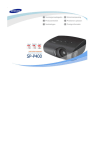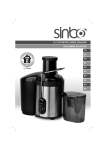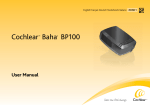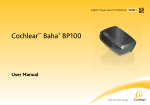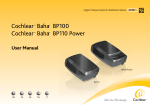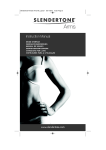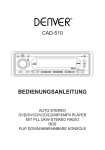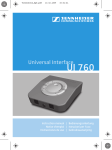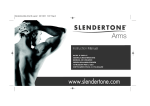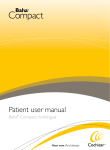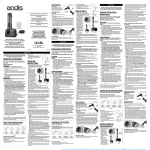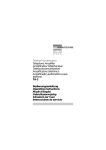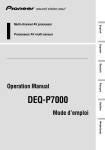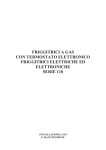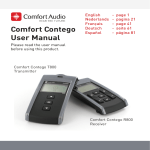Download Cordelle II Baha
Transcript
English Français Deutsch Nederlands Italiano ZONE 1 Baha Cordelle II ® User Manual y x u U WV X w v at ak am al al w an Instructions English 4 Français 26 Deutsch 48 Nederlands 70 Italiano 92 English English y Baha® Cordelle II WV w x u U v w X at ak am al u Head worn unit v Body worn unit w Cord x Program switch (M/MT/T) y Direct audio input U Tone switch V Volume control, on/off W Microphone X Electrical output at Clip ak Battery compartment al Serial number am Plastic snap connector an Electrical input The Baha® Cordelle II is a bone conduction sound processor. The Cordelle II is the most powerful Baha sound processor and consists of a body worn unit connected to a head worn unit. The Baha® bone conduction system works by combining a sound processor with an abutment and a small titanium implant placed in the skull behind the ear. The system is based on a process of osseointegration through which living bone tissue integrates with titanium. Thus, the titanium implant becomes one with the bone allowing sound to be conducted via the skull bone directly to the cochlea and improving your hearing. Please read this manual carefully to learn how to use and maintain your sound processor. Be sure to discuss any questions or concerns that you may have regarding hearing, or use of this system, with your hearing care professional. al an 4 5 English English We strive to provide the best possible products and services to our clients. Your views and experiences of our products and services are important to us. If you have any comments you would like to share, please contact us: Address: Customer Service - Cochlear Americas 13059 E. Peakview Avenue, Centennial, CO 80111, USA Toll free (North America) 1800 523 5798 Tel: +1 303 790 9010 Fax: +1 303 792 9025 Email: [email protected] Customer Service - Cochlear Europe 6 Dashwood Lang Road, Bourne Business Park, Addlestone, Surrey KT15 2HJ, UK Tel: +44 1932 87 1500 Fax: +44 1932 87 1526 Email: [email protected] Customer Service - Cochlear Asia Pacific 1 University Avenue, Macquarie University, NSW 2109, Australia Toll free (Australia) 1800 620 929 Toll free (New Zealand) 0800 444 819 Tel: +61 2 9428 6555 Fax: +61 2 9428 6352 or Toll free 1800 005 215 Email: [email protected] 6 Getting started Connecting and disconnecting the unit A plastic snap connector is mounted to the head worn unit. It is designed to snap onto the abutment and hold the head worn unit securely in place. The body worn unit is equipped with a clip so you can attach the unit to your clothes. The audio cord is connected by attaching the angulated plug to the body worn unit and the straight plug to the head worn unit (see pictures on the inside of the cover). The three-pin plug is reversible. Connecting 1 Hold the head worn unit so that the plastic snap connector is accessible and move any hair away from the abutment. Push the device carefully in with a tilting motion and it will attach to the abutment. 1 Disconnecting 2 Tilting the head worn unit slightly in any direction will release it from the abutment. Warning! Do not push the head worn unit straight in and do not pull it straight out. This puts pressure on the abutment and may cause discomfort. 2 7 English English On/Off and Volume control Program switch Off When the volume control is in the 0 position it is off. You will feel a “click” as it goes into off mode. On For the sound processor to be on, the volume control must be set to a position higher than 0. You will feel a click as the sound processor moves from off mode to on mode. The body worn unit is equipped with a program switch for the telecoil function. The telecoil improves sound quality and speech understanding when using telephones in homes where there are personal loop systems installed and in other buildings with loop facilities. Volume control If you turn the volume control towards the M/T switch the volume increases, and if you turn it away from the M/T switch it will decrease. There are three programs available. “M” is for listening with the microphone only. In program “M/T” both the microphone and telecoil are active. In program “T” only the telecoil is active. Tone switch The tone switch controls the frequency response. The switch can be set in three different positions. N = Normal. This gives the widest frequency response. H = High frequency emphasis. This setting reduces low frequency sounds, which often can improve speech understanding. L = Low frequency emphasis. This position is often useful during the first period after fitting as it allows you to gradually get used to high frequency sounds you have not heard in a long time. Trim controls There are two trim controls on the back of the body worn unit. These are to be adjusted by audiologists only. When fitting the Cordelle, the audiologist will set these trimmers to suit your needs. The tone switch is effective for all inputs (microphone, telecoil and accessories connected via the direct audio input). 8 9 English English Telephones and mobiles Hold the telephone or mobile “upside down” close to the microphone (using the M program) or close to the telecoil (if using the MT or T program) as seen to the left. The telecoil is placed vertically, close to the electrical input. Please note the magnetic field from many modern phones is not strong enough to be picked up by the telecoil. Some phones can be equipped with a neck-loop to reinforce the magnetic field. It is important that neither you, nor the phone, touches the sound processor as this may cause feedback (“whistling”). Care and maintenance Cleaning the abutment area When the last dressing has been removed and the abutment is exposed hygiene continues to be very important. Daily care On a daily basis the area around the abutment should be cleaned to avoid debris build-up. This build-up around the base of the abutment is not a scab and must be removed. Cleaning this area is most easily done when you bath or take a shower as plenty of warm water and soap on the area will help to soften any crust that may have developed around the base of the abutment. The soft brush, which was provided with your sound processor, should be used for cleaning. During the first weeks, after the dressing is removed, cleaning with the soft brush may feel a little rough. If so, use a strip of baby wipe until your skin becomes less sensitive and you can use the brush comfortably. The soft brush can be used with any mild soap or shampoo and plenty of warm water. 10 11 English English When you brush, aim the bristles at the side of the abutment rather than at the skin. Your focus should be to remove crust and debris around the base of the abutment rather than brushing your skin. Your skin is delicate and should not be treated too harshly. Remember, it is important to keep your soft brush clean too! After cleaning, gently dry the area around the abutment with a clean towel or tissue. Do not allow your hair to wrap itself around the abutment. If you use a hairdryer do not keep hot air on the abutment for too long. Weekly care If you use an abutment cover it will help keep the inside of the abutment clean. However, the inside of the abutment should still be cleaned on a weekly basis. The soft brush can also be used for cleaning inside the abutment. Again, this is best done in conjunction with a bath or shower when soap and warm water can soften dirt making it easy to remove. You will have routine check-ups, initially every 4-6 months and later every 6-12 months. However, should you experience any persistent irritation, soreness or any other signs of inflammation around the abutment, always contact your doctor. Maintenance of your Baha® Cordelle II Do not get the sound processor wet. The sound processor can be worn during waking hours apart from when you take a bath, shower, or swim. Keep in mind that the sound processor consists of two delicate electrical devices that should be used with due care and attention. When engaging in physical activities, use common sense. If the activity is of such a nature that the sound processor risks getting damaged (for example contact sports) – remove it! Skin debris or any other dirt in the abutment can prevent a smooth fitting of the abutment to your abutment cover and head worn unit. This could potentially lead to damage of your head worn unit. 12 13 English English When not using your Baha® Cordelle II Batteries When not in use ensure that the sound processor is switched off and stored carefully where the head worn unit and body worn unit will not gather dust and dirt. If you will not be using the sound processor for any length of time, remove the battery from the body worn unit. To maintain a good snap connection to the abutment, we recommend that you use an abutment cover when not wearing your head worn unit. The Cordelle II is powered by a 9 V battery. Three rechargeable batteries are included with your Cordelle II and these should last for many years if handled with appropriate care. However, non-rechargeable batteries can also be used. Cleaning your Baha sound processor Ensure that your snap coupling is always visibly clean. Use a brush for cleaning purposes. (A regular toothbrush with hard bristles is suitable). Do not use water or other liquids when cleaning your Baha. Keep the plastic housings clean by regularly wiping with a soft, dry cloth. Attention: For children who have been fitted with a Baha sound processor it is extremely important that the parent or caregiver of the child provides all necessary assistance and support in cleaning and maintenance, as detailed above. 14 Battery replacement Open the battery compartment by pressing the cover at the bottom of the body worn unit and lift it up. Turn the body worn unit over and the battery will fall out. If it gets stuck you can shake the device carefully. Place the new battery with the + mark facing the + mark in the battery compartment. Push the battery in and close the cover. Warning! The Baha sound processor contains small parts that may be a risk for small children. Batteries can be harmful if swallowed. Be sure to keep your batteries out of reach of small children, people of diminished mental capacity and pet animals. In the event a battery is accidentally swallowed, seek medical attention immediately at the nearest emergency centre. 15 English English Battery life To maximise battery life, switch off the sound processor when not in use. Battery life varies depending on volume setting, the sound environment and the program setting. Battery life will decrease significantly when using the Baha sound processor with a connected FM receiver if the FM receiver uses the sound processor as its power source. Using powerful batteries is particularly important when high current consumption is common. Battery function can be related to a number of problems including: no sound, intermittent sound and crackling/buzzing. Thus, when encountering problems one of the first things one can do is to try recharging or changing the battery. Batteries have to be charged for 2-4 hours before use. A suitable battery charger can be purchased from Cochlear or a local electronics store. We recommend “intelligent” fast chargers for NiMH batteries. Non-rechargeable batteries Non-rechargeable batteries usually have a higher capacity and last longer. Batteries from different manufacturers tend to vary in size. If possible test the battery to make sure it fits and will function properly prior to purchase. Warning! Non-rechargeable batteries cannot be recharged! Rechargeable batteries A fully charged battery will normally last for 1-2 days but this can vary considerably depending on settings and the sound environment. Do not forget to switch off the body worn unit when you are not using it to save the battery. Note: Always follow local regulations for battery disposal. Due to self-discharge, battery capacity always decreases over time. A fully charged battery will have about 80% of its capacity left after one month (60% after 6 months). After long storage, several charge/discharge cycles may be necessary to restore full capacity. 16 17 English English General advice • A sound processor will not restore normal hearing and will not prevent or improve a hearing impairment resulting from organic conditions. • Infrequent use of a sound processor does not permit a user to attain full benefit from it. • The use of a sound processor is only part of hearing rehabilitation and may need to be supplemented by auditory training and instructions in lip-reading. • The Baha® Cordelle II is suitable for use in electromagnetic environments with mains power of typical commercial or hospital quality, and power frequency magnetic fields of typical commercial or hospital levels. It is intended for use in an electromagnetic environment in which radiated RF (radio frequency) disturbances are controlled. • Interference may occur in the vicinity of equipment with the symbol to the left. • For advice on “do’s and don’ts” for your Baha sound processor see the section on Warnings and Precautions (p. 22). 18 Accessories Several accessories are available to enhance your sound experience in different contexts. To ensure the smooth operation of your Baha, only use Cochlear original accessories or accessories approved by Cochlear. Phonak FM-receiver Enables the use of most Phonak FM transmitters. For more information and orders contact your local Phonak distributor www.phonak.com. Direct audio input and microphone settings The body worn unit is equipped with a direct audio input designed for connecting external equipment. The M/T switch automatically switches off the telecoil, if external equipment is connected, as well as regulating which sound sources are accessed (see table on page 20). Depending on the signal level, the volume control may have to be adjusted to achieve a normal listening level. If sound is distorted at a normal listening level, the electrical signal into the Cordelle II may be too high. If possible reduce the volume at the signal source so that the volume control on the Cordelle II can be left in a normal position. 19 English English Sound sources accessed M/T switch position Direct audio input NOT connected Direct audio input connected M Microphone only Microphone only M/T Microphone and telecoil Microphone and direct audio input T Telecoil only Direct audio input only Safety instructions when connecting external equipment Only connection cables and accessories that are supplied or approved by Cochlear should be used. Non-standard connection cables can cause damage to the sound processor and injury to you. If in doubt, consult your audiologist. Cochlear is not liable for any damages arising as a result of this, or any other form of incorrect use of the product or its parts. 20 Warning! It is extremely dangerous and potentially fatal to connect any equipment that is plugged into a 110 and/or 220 V power supply without using the audio adapter. Abutment cover An abutment cover is included in the sound processor kit. The cover helps conceal and protect the abutment when the sound processor is not in place. This improves aesthetics and prevents dirt from collecting in the abutment, which helps maintain a good snap connection between the abutment and sound processor. Simply press the cover gently onto the abutment. Share the Experience The test rod provided can be used by others so that they can listen to your Baha sound processor themselves. Snap the unit onto the test rod and hold the rod against the skull bone behind the ear while keeping the ears plugged (take care not to allow the sound processor to touch anything except the test rod as this may cause feedback). 21 English English +50°C (+122°F) -20°C (-4°F) 22 Warnings and precautions Troubleshooter • The sound processor is a digital, electrical, medical device designed for specific use. As such, due care and attention must be exercised by the user at all times. • Neither the body worn unit nor the head worn unit are waterproof! Never wear them in the bath or shower! If the body worn unit gets wet by accident open the battery door immediately and take out the battery. Leave the battery door open until it is dry. • Do not expose the sound processor to extreme temperatures. For example do not wear it in the sauna. The sound processor is designed to operate within the temperature ranges +5°C (+41°F) to +40°C (+104°F). In particular, battery performance deteriorates in temperatures under +5°C. The device should not be subject, at any time, to temperatures below -20°C (-4°F) or above +50°C (+122°F). • This product is not suitable for use in the presence of flammable materials. • If you are to undergo an MRI (Magnetic Resonance Imaging) procedure, the head worn unit should be removed beforehand. The implant and abutment remain in place. • Portable and mobile RF (radio frequency) communications equipment can affect the performance of your Baha. • Dispose of electronic items in accordance with your local regulations. • Do not dispose of in fire. If you encounter any problems with your Baha sound processor: • Check that the head worn unit is not touching anything (such as a hat, eyeglasses or similar items). • Check the volume control. • Check the program setting. • Try changing the battery. If the problem persists, contact your audiologist to get it mended. Do not try fixing the sound processor yourself. 23 English English Service, repairs & warranty Key to symbols Service and repairs Throughout the manual you will see small symbols. Please refer to the list below for explanations: If there is any fault with your Baha sound processor, contact your ear clinic or hearing aid centre and they will help you to get it serviced. Telephone number of hearing centre:______________________________ Contact person: _ ______________________________________________ Telephone number of ear clinic:___________________________________ Contact person:________________________________________________ Symbol Explanation Symbol Explanation “Consult instructions for use” or “Consult operating instructions” Interference risk “Caution, consult accompanying documents” or “Attention, see instructions for use” Date of manufacture Warranty Audible signal Batch Code The warranty does not cover defects or damage arising from, associated with, or related to the use of this Product with any non-Cochlear processing unit and/or any non-Cochlear implant. See “Cochlear Baha Global Limited Warranty card” for more details. CE-mark SN Serial Number Temperature limitation DISCLAIMER: Cochlear reserves the right to make any necessary changes and improvements to the product. 24 25 Français Français y Baha® Cordelle II WV w x u U v w X at ak am al al u Partie vibrateur v Boîtier w Cordon x Commutateur (M/MT/T) y Entrée audio directe U Commutateur de tonalité V Potentiomètre W Microphone X Sortie électrique at Clip ak Compartiment pile al Numéro de série am Vibrateur type bouton-pression an Entrée électrique Le Baha® Cordelle II est un processeur externe qui utilise la conduction osseuse directe pour transmettre les sons à la cochlée (oreille interne). Le Cordelle Il est constitué d’un boîtier raccordé à une partie vibrateur. Il est le processeur Baha le plus puissant. Le système Baha se compose d’un processeur électronique externe et d’un petit implant en titane placé dans l’épaisseur de l’os temporal derrière l’oreille. Cet implant s’intègre totalement dans l’os crânien sous l’effet d’un processus appelé ostéo-intégration. Ceci permet une conduction directe du son vers la cochlée à travers l’os crânien, ce qui améliore les performances auditives. Seuls les produits et accessoires Cochlear, ou les produits et accessoires agréés par Cochlear, y compris les processeurs, les implants et les piliers, peuvent être utilisés ensemble pour assurer le maintien de la garantie. Lisez attentivement ce manuel pour découvrir le fonctionnement et l’entretien du processeur externe. En cas de questions ou de problèmes concernant l’utilisation de ce système, adressez-vous à votre audiologiste. an 26 27 Français Français Nous nous efforçons d’offrir les meilleurs produits et services possibles à nos clients. Votre opinion et votre expérience sont importantes pour nous. Si vous souhaitez nous faire parvenir vos commentaires, n’hésitez pas à nous contacter : Adresse : Customer Service - Cochlear Americas 13059 E. Peakview Avenue, Centennial, CO 80111, USA Toll free (North America) 1800 523 5798 Tel: +1 303 790 9010 Fax: +1 303 792 9025 Email: [email protected] Customer Service - Cochlear Europe 6 Dashwood Lang Road, Bourne Business Park, Addlestone, Surrey KT15 2HJ, UK Tel: +44 1932 87 1500 Fax: +44 1932 87 1526 Email: [email protected] Customer Service - Cochlear Asia Pacific 1 University Avenue, Macquarie University, NSW 2109, Australia Toll free (Australia) 1800 620 929 Toll free (New Zealand) 0800 444 819 Tel: +61 2 9428 6555 Fax: +61 2 9428 6352 or Toll free 1800 005 215 Email: [email protected] 28 Premiers pas Adaptation et retrait du processeur externe Le processeur externe est doté d’un système de fixation type bouton-pression en plastique conçu pour s’adapter sur le pilier et le maintenir fermement en place. Le boîtier est équipé d’un clip permettant de le fixer à vos vêtements. Pour raccorder le cordon audio, connectez la fiche à broches perpendiculaires au boîtier et la fiche droite à la partie vibrateur (voir illustrations à l’intérieur de la couverture). La fiche à trois broches est réversible. Adaptation 1 Écartez les cheveux gênants du pilier. Tenez la partie vibrateur pour rendre la fixation type bouton-pression accessible. Mettez le vibrateur au contact du pilier en prenant un angle puis remettez-le dans l’axe en poussant doucement. La partie vibrateur se fixera sur le pilier. 1 Retrait 2 Pour libérer la partie vibrateur, tenez la, glissez un doigt dessous et faites-la pivoter doucement jusqu’à ce qu’elle se détache. Attention ! Utilisez la technique préconisée pour mettre en place et retirer votre processeur externe sûrement et confortablement, afin de réduire toute pression inutile sur le vibrateur type bouton-pression et sur le pilier. Ainsi, vous éviterez toute gêne. 2 29 Français Français Marche/arrêt Commutateur M, MT, T Arrêt Lorsque le potentiomètre se trouve sur 0, le processeur externe est éteint. Vous sentirez un clic au moment où il s’éteint. Marche Pour allumer le processeur externe, tournez le potentiomètre et positionnez le à un niveau sonore confortable. Vous sentirez un clic lorsque le processeur s’allume. Le boîtier est équipé d’un commutateur M, MT, T pour la fonction boucle à induction. Cette dernière permet d’améliorer la qualité sonore et la compréhension de la parole au téléphone, et dans les lieux où sont installés des systèmes de boucle. Potentiomètre Si vous tournez le potentiomètre vers le commutateur M/T, le volume augmente ; si vous tournez le potentiomètre dans l’autre sens, le volume diminue. Trois positions sont disponibles. « M » permet l’écoute via le microphone uniquement. En position « M / T », le microphone et la boucle à induction sont tous deux actifs. En position « T », seule la boucle à induction est active. Commutateur de tonalité Ce commutateur contrôle la bande passante. Il peut être réglé sur trois positions différentes : N = position normale. Cette position fournit la bande passante la plus large. H = Accentuation des hautes fréquences. Ce réglage réduit les sons de basse fréquence, ce qui améliore souvent le compréhension de la parole. L = Accentuation des basses fréquences. Cette position est souvent utile pendant la période suivant la pose, car elle permet au patient de s’habituer progressivement aux sons de fréquence élevée qu’il n’a plus entendus depuis longtemps. Trimmer de réglage Sur la partie arrière du boîtier se trouvent deux trimmers de réglage. Ils ne peuvent être utilisés que par des audiologistes. Lors de l’adaptation du Cordelle, l’audiologiste règlera votre processeur selon vos besoins. Le commutateur de tonalité convient pour toutes les entrées (microphone, boucle à induction et accessoires connectés via l’entrée audio directe). 30 31 Français Français Téléphones fixes et portables Tenez le téléphone ou le portable « à l’envers » près du microphone (si vous utilisez le programme M) ou près de la boucle à induction (si vous utilisez les programmes MT ou T), comme le montre l’image à gauche. La boucle à induction est placée verticalement, près de l’entrée audio. Veuillez noter que le champ magnétique d’un grand nombre de téléphones modernes n’est pas suffisamment intense pour être capté par la boucle à induction. Certains téléphones peuvent être équipés d’une boucle magnétique pour renforcer le champ magnétique. Il est important que ni vous ni le téléphone ne touchiez le boîtier du processeur, afin d’éviter tout larsen (« sifflement »). Soins et maintenance Nettoyage de la zone du pilier Après le retrait du dernier pansement, il est très important de continuer à respecter les règles d’hygiène puisque le pilier est exposé. Soins quotidiens Vous devez nettoyer la zone autour du pilier tous les jours pour éviter l’accumulation de débris. Les débris formés ne sont pas des croûtes et doivent donc être retirés. Il est plus simple de nettoyer cette zone lors d’un bain ou sous la douche puisque l’eau chaude et le savon aideront à ramollir toute croûte ayant pu se former autour de la base du pilier. Pour le nettoyage, veuillez utiliser la brosse douce fournie avec votre processeur. Au cours des premières semaines suivant le retrait du pansement, la brosse douce peut vous provoquer une certaine gêne. Si tel est le cas, vous pouvez utiliser une lingette pour bébé jusqu’à ce que votre peau soit moins sensible et que vous puissiez commodément employer la brosse. La brosse douce peut être utilisée avec tout type de savon doux ou de shampoing et beaucoup d’eau chaude. 32 33 Français Français Au moment du brossage, orientez les poils de la brosse vers le pilier et non vers la peau. L’objectif de ce brossage est d’éliminer les croûtes et débris autour de la base du pilier. Votre peau est délicate, ne la traitez donc pas trop durement. Et n’oubliez pas qu’il est également important que votre brosse douce reste propre ! Après le nettoyage, séchez soigneusement la zone autour du pilier avec une serviette ou un mouchoir propre. Ne laissez pas vos cheveux s’enrouler autour du pilier. Si vous utilisez un sèche-cheveux, ne dirigez pas trop longtemps l’air chaud vers le pilier. Soins hebdomadaires Un couvre pilier vous aidera à maintenir l’intérieur du pilier propre. Vous devrez néanmoins le nettoyer une fois par semaine. Vous pouvez également utiliser la brosse douce pour nettoyer l’intérieur du pilier. Là aussi, il est plus facile de le faire lors d’un bain ou d’une douche puisque le savon et l’eau chaude facilitent l’élimination des débris en les ramollissant. Au début, vous vous présenterez à des contrôles de routine tous les 4 à 6 mois, puis tous les 6 à 12 mois. Contactez toutefois votre médecin en cas de problèmes persistants autour du pilier, par exemple une irritation ou une douleur. Maintenance de votre processeur Baha® Cordelle II Ne mouillez pas le processeur. Vous pouvez porter votre processeur externe toute la journée, sauf lors d’un bain, sous la douche ou lorsque vous nagez. N’oubliez pas que le processeur est constitué de deux appareils électroniques délicats qui doivent recevoir tous les soins et toute l’attention nécessaires. Si vous pratiquez des sports, faites preuve de bon sens ! Si votre processeur externe risque d’être endommagé (sports de contact, par ex.), retirez-le. Les débris de peau et de toute autre nature dans le pilier peuvent compliquer la mise en place de votre processeur externe. Ils pourraient même endommager ce dernier. 34 35 Français Français Lorsque vous n’utilisez pas votre Baha® Cordelle II Piles Lorsque vous ne l’utilisez pas, veillez à ce que votre processeur soit éteint et conservé soigneusement dans un endroit où la partie vibrateur comme le boîtier seront protégés de la poussière et autres salissures. Si vous ne comptez pas l’utiliser pendant un certain temps, retirez la pile du boîtier. Lorsque vous n’utilisez pas votre processeur de son, nous vous conseillons d’utiliser le couvre pilier pour une prochaine mise en place sans soucis. Le Cordelle II est alimenté par une pile de 9 V. Trois piles rechargeables sont incluses avec votre Cordelle II. Elles devraient durer pendant de nombreuses années si elles sont traitées de façon adéquate. Il est également possible d’utiliser des piles non rechargeables. Nettoyage de votre processeur externe Baha Veillez à ce que le système de fixation type bouton-pression soit toujours visiblement propre. Pour le nettoyage de votre Baha, n’utilisez pas d’eau ni d’autres liquides. Veillez à ce que le boîtier du processeur externe reste propre en l’essuyant régulièrement avec un chiffon doux et sec. Attention : Pour les enfants portant un implant auditif Baha, il est extrêmement important que les parents ou responsables de l’enfant fournissent toute l’aide nécessaire à l’enfant dans les tâches de nettoyage et de maintenance (voir détails ci-dessus). 36 Remplacement de la pile Ouvrez le compartiment pile en appuyant sur le couvercle au bas du boîtier et soulevez-le. Retournez le boîtier pour que la pile tombe. Si la pile reste bloquée, secouez doucement le boîtier. Placez la pile neuve en faisant correspondre le repère + de la pile avec celui du compartiment. Enfoncez la pile et refermez le couvercle. Attention ! Le processeur externe Baha contient de petites pièces qui peuvent présenter un risque pour les jeunes enfants. Les piles peuvent être dangereuses si elles sont avalées. Conservez toujours les piles hors de portée des enfants et des personnes présentant un retard mental. Il en est de même pour les animaux domestiques. Si une pile est avalée par accident, demandez immédiatement une aide médicale auprès du centre d’urgences le plus proche. 37 Français Français Durée de vie de la pile Pour faire durer au maximum la pile, éteignez votre processeur externe lorsque vous ne l’utilisez pas. La durée de vie d’une pile varie selon le réglage du volume, l’environnement sonore et le programme choisi. La durée de vie d’une pile est sensiblement réduite lorsque le processeur Baha est utilisé avec un récepteur FM sans alimentation propre. Il est extrêmement important d’utiliser des piles puissantes lorsque la consommation d’énergie est généralement élevée. Les piles peuvent être liées à un certain nombre de problèmes, notamment : l’absence de son, un fonctionnement intermittent ou des craquements/bourdonnements. Si vous avez donc un quelconque problème avec votre processeur Baha, pensez en premier lieu à recharger la pile ou à la remplacer. Batteries rechargeables Une batterie entièrement chargée dure normalement 1 à 2 jours, mais cette durée peut varier considérablement en fonction des réglages et de l’environnement sonore. Lorsque vous n’avez pas besoin de votre processeur Baha, n’oubliez pas de l’éteindre pour économiser la batterie. Les batteries doivent être chargées pendant 2 à 4 heures avant leur utilisation. Un chargeur de batterie adapté peut être acheté chez Cochlear ou dans un quelconque magasin de fournitures électroniques. Nous recommandons d’utiliser des chargeurs rapides “intelligents” de batteries NiMH. Piles non rechargeables Les piles non rechargeables ont en général une capacité plus élevée et durent plus longtemps. En fonction de la marque, les piles ont souvent des dimensions différentes. Si possible, testez la pile avant de l’acheter pour vous assurer qu’elle soit de la bonne dimension et qu’elle fonctionne correctement. Attention ! Les piles non rechargeables ne peuvent pas être rechargées! Remarque : respectez les réglementations locales pour la mise au rebut des piles. A cause d’un phénomène de décharge naturelle, la capacité de la batterie diminue toujours avec le temps. Une batterie complètement chargée n’aura plus que 80% de sa capacité après un mois (60% après 6 mois). Après une longue période de conservation, de nombreux cycles de chargement/déchargement peuvent être nécessaires pour rétablir la pleine capacité. 38 39 Français Français Conseils généraux • Un processeur externe ne rétablit pas une ouïe normale et ne peut empêcher ni améliorer une perte auditive due à des causes organiques. • Une utilisation irrégulière du processeur ne permet pas à l’utilisateur d’en tirer le meilleur bénéfice possible. • L’utilisation d’un processeur Baha ne représente qu’une part de la réhabilitation auditive et il peut être nécessaire de compléter cette utilisation par une rééducation et un apprentissage de la lecture labiale. • Le Baha® Cordelle II peut être utilisé dans les environnements électromagnétiques tout public tels que les centres commerciaux ou les hôpitaux. Il peut être utilisé dans un environnement électromagnétique où les perturbations radiofréquences sont contrôlées. • Des interférences peuvent se produire à proximité d’appareils portant le symbole ci-contre. • Pour obtenir des conseils sur ce que vous devez et ne devez pas faire avec votre processeur Baha, consultez la section Avertissements et précautions en page 44. 40 Accessoires Plusieurs accessoires sont disponibles pour améliorer la qualité sonore dans différents contextes. Pour que votre appareil Baha fonctionne parfaitement, utilisez uniquement des accessoires originaux de Cochlear ou, à défaut, approuvés par Cochlear. Récepteur FM Phonak Permet d’utiliser la plupart des émetteurs FM Phonak. Pour de plus amples informations ou passer une commande, contactez votre distributeur Phonak le plus proche (www.phonak.com). Réglages du microphone et de l’entrée audio directe Le boîtier est équipé d’une entrée audio directe pour la connexion d’équipements externes. Le commutateur M/T coupe automatiquement la boucle à induction si un équipement externe est connecté et permet de régler l’accès aux sources sonores (voir le tableau de la page 42). En fonction du niveau du signal, le volume peut être réglé pour obtenir un niveau d’écoute normal. Si le son présente des distorsions à un niveau d’écoute normale, le signal électrique envoyé au Cordelle II est peut-être trop élevé. Si possible, réduisez le volume de la source du signal de manière à laisser le volume du Cordelle II en position normale. 41 Français Français Sources sonores accessibles Position du commutateur M/T Entrée audio directe NON connectée Entrée audio directe connectée M Microphone uniquement Microphone uniquement M/T Microphone et boucle à induction Microphone et entrée audio directe T Boucle à induction uniquement Entrée audio directe uniquement Instructions de sécurité pour la connexion d’un équipement externe Utilisez uniquement les câbles de connexion fournis ou approuvés par Cochlear. Des câbles de connexion non standard risquent d’endommager le processeur et de vous blesser. En cas de doute, consultez votre audioprothésiste. Cochlear n’est pas responsable des dommages survenant suite à l’utilisation de câbles non approuvés ou de toute autre forme incorrecte d’utilisation du produit ou de ses pièces. 42 Attention ! Il est extrêmement dangereux et peut se révéler mortel de connecter un équipement branché sur une alimentation électrique de 110 et/ou 220 V sans utiliser l’adaptateur audio. Couvre pilier Un couvre pilier est inclus dans le kit du processeur Baha. Ce couvre pilier aide à dissimuler et à protéger le pilier lorsque le processeur n’est pas en place. Il offre une certaine esthétique et évite que des poussières ne se déposent dans le pilier. Il vous suffit de presser doucement le couvre pilier sur le pilier. Partagez votre expérience Les membres de la famille et les amis peuvent “partager l’expérience” de l’audition en conduction osseuse. La baguette de test permet aux autres de simuler l’audition à l’aide du processeur externe Cochlear Baha Divino. Adaptez le processeur externe sur la baguette de test de la même manière que vous le placez sur le pilier. Appuyez la baguette de test contre l’os du crâne derrière une oreille. Bouchez les deux oreilles et faites du bruit. Pour éviter les larsens (sifflements), le processeur externe ne doit toucher aucun autre objet que la baguette de test. 43 Français Français +50°C (+122°F) -20°C (-4°F) 44 Avertissements et précautions Dépannage • Le processeur externe Baha est un appareil numérique, électrique et médical destiné à un usage précis. En tant que tel, l’utilisateur doit en prendre soin à chaque instant. • Ni la partie vibrateur du processeur externe, ni le boîtier ne sont étanches ! Ne les portez jamais en prenant un bain ou une douche ! Si le boîtier devait être mouillé accidentellement, ouvrez immédiatement le couvercle du logement de la pile et sortez cette dernière. Laissez le logement de la batterie ouvert jusqu’à ce qu’il soit tout à fait sec. • N’exposez pas le processeur à une chaleur excessive. Ne le portez pas dans un sauna, par exemple. Le processeur de son a été conçu pour fonctionner entre +5 °C (+41 °F) et +40 °C (+104 °F). Le rendement de la pile se verra sensiblement affecté par des températures inférieures à +5 °C. N’exposez jamais et sous aucun prétexte le dispositif à des températures inférieures à -20 °C (-4 °F) et supérieures à +50 °C (+122 °F). • Il convient de ne pas utiliser ce produit en présence de matériaux inflammables. • Retirez le processeur externe avant tout examen IRM (imagerie par résonance magnétique). L’implant et le pilier restent en place. • Des équipements de communication portables et par RF (radiofréquence) peuvent affecter les performances de votre Baha. • Respectez les réglementations locales pour la mise au rebut des composants électroniques. • Ne pas jeter dans les flammes. En cas de problème avec votre processeur Baha : • Assurez-vous que chapeaux, lunettes et autres objets n’entrent pas en contact avec le processeur Cochlear Baha Cordelle II. • Contrôlez le volume. • Vérifiez le programme choisi. • Remplacez la pile. Si le problème persiste, contactez votre audioprothésiste. N’essayez jamais de réparer le processeur externe Baha vous-même. 45 Français Français Service, réparations et garantie Explication des symboles Service et réparations Dans ce manuel, vous verrez de petits symboles. Veuillez vous référer à la liste ci-dessous pour leur explication. Si votre processeur de son Baha présente une défaillance, contactez votre centre d’implantation ou centre d’aide auditive pour le faire réparer. Numéro de téléphone du centre auditif : __________________________ Personne à contacter : __________________________________________ Numéro de téléphone du centre d’implantation :____________________ Personne à contacter :___________________________________________ Garantie La garantie ne couvre pas les défauts ou dommages dus, associés ou liés à l’utilisation de ce Produit avec tout processeur externe et/ou tout implant non produit par Cochlear. Consultez la « Fiche de garantie limitée globale Cochlear » pour plus de détails. Symbole Explication Symbole Explication “Se reporter à la notice d’utilisation” Risque d’interférence “Attention, se reporter aux instructions d’utilisation” Date de fabrication Signal sonore N° de lot Marquage CE SN Numéro de série Limites de température CLAUSE DE NON-RESPONSABILITÉ : Cochlear se réserve le droit d’apporter les modifications et améliorations nécessaires au produit. 46 47 Deutsch Deutsch y Baha Cordelle II WV ® w x u U v w X at ak am al al an 48 u Kopfgerät v Taschengerät w Kabel x Programmschalter (M/MT/T) y Direkter Audioeingang U Klangschalter V Lautstärkeregler, ein/aus W Mikrofon X Elektrischer Ausgang at Clip ak Batteriefach al Seriennummer am Schnappkupplung an Anschlussbuchse Baha Cordelle II ist ein Hörverstärker, der auf dem Prinzip der Knochenleitung basiert. Cordelle II ist das leistungsstärkste Baha-System und besteht aus einem am Körper getragenen Gerät, das mit einem am Kopf getragenen Gerät verbunden ist. Das Baha -Knochenleitungssystem kombiniert Hörverstärker mit Kupplung und einem kleinen Titanimplantat, das hinter dem Ohr im Schädel eingesetzt wird. Das System basiert auf dem sog. Osseointegrationsprozess, bei dem vitales Gewebe eine Verbindung mit Titan eingeht. Mit dem Baha-System wird der Schall aus der Luft aufgenommen, verstärkt und in Vibrationsschall umgewandelt. Über die Schnappkupplung, das Titanimplantat und den Knochen können die Schwingungen direkt an das Innenohr (cochlea) weitergeleitet werden. Außenohr und Mittelohr werden dabei umgangen und das Sprachverstehen über die Knochenleitung verbessert. Um die Garantie zu gewährleisten, sind ausschließlich CochlearProdukte und -Zubehör bzw. von Cochlear zugelassene Produkte und Zubehör einschließlich Hörverstärkern, Implantaten und Schnappkupplungen zusammen zu verwenden. ® ® Lesen Sie das Benutzerhandbuch sorgfältig durch, damit Sie sich mit Ihrem Soundprozessor vertraut machen können. Selbstverständlich können Sie alle Fragen oder Bedenken bezüglich des Hörens oder zum Gebrauch des Systems mit Ihrem Hörgeräteakustiker besprechen. 49 Deutsch Deutsch Wir bemühen uns stets, unseren Kunden die besten Produkte und Serviceleistungen anzubieten. Ihre Meinung ist uns wichtig. Wenn Sie Anregungen zu unseren Produkten und Serviceleistungen haben, schreiben Sie uns an folgende Adresse: Adresse: Customer Service - Cochlear Americas 13059 E. Peakview Avenue, Centennial, CO 80111, USA Toll free (North America) 1800 523 5798 Tel: +1 303 790 9010 Fax: +1 303 792 9025 Email: [email protected] Customer Service - Cochlear Europe 6 Dashwood Lang Road, Bourne Business Park, Addlestone, Surrey KT15 2HJ, UK Tel: +44 1932 87 1500 Fax: +44 1932 87 1526 Email: [email protected] Customer Service - Cochlear Asia Pacific 1 University Avenue, Macquarie University, NSW 2109, Australia Toll free (Australia) 1800 620 929 Toll free (New Zealand) 0800 444 819 Tel: +61 2 9428 6555 Fax: +61 2 9428 6352 or Toll free 1800 005 215 Email: [email protected] 50 Start So verbinden und trennen Sie das Gerät. Am Kopfgerät ist eine Kunststoff-Schnappkupplung montiert. Sie wurde so entwickelt, dass sie in der Kupplung einrastet und das Kopfgerät sicher an seinem Platz hält. Das am Körper getragene Gerät ist mit einem Clip ausgerüstet, um es an der Kleidung zu befestigen. Das Tonkabel wird mit dem angewinkelten Stecker an der am Körper getragenen Einheit befestigt. Der gerade Stecker wird an der am Kopf getragenen Einheit angebracht (siehe Abbildungen auf der Umschlaginnenseite). Der dreipolige Stecker ist reversibel. Verbinden 1 Halten Sie das am Kopf getragene Gerät so, dass die KunststoffSchnappkupplung zugänglich ist. Entfernen Sie Ihre Haare aus dem Bereich der Kupplung. Drücken Sie das Gerät vorsichtig mit einer Kippbewegung hinein, bis es in der Kupplung einrastet. 1 Trennen 2 Kippen Sie die am Kopf getragene Einheit leicht in eine beliebige Richtung, um sie aus der Schnappkupplung zu lösen. Achtung! Die am Kopf getragene Einheit darf auf keinen Fall gerade aufgesetzt oder abgezogen werden. Dies setzt die Schnappkupplung unter Druck und kann als unangenehm empfunden werden. 2 51 Deutsch Deutsch Lautstärkeregler ein/aus Programmschalter Aus Steht der Lautstärkeregler auf 0, ist das Gerät ausgeschaltet. Sie nehmen ein “Klicken” wahr, wenn sich das Gerät ausschaltet. Ein Zum Einschalten des Hörverstärkers muss der Lautstärkeregler auf einen Wert höher als 0 eingestellt sein. Sie nehmen ein Klicken wahr, wenn sich das Gerät einschaltet. Lautstärkeregeler Drehen Sie den Lautstärkeregler in Richtung M/T-Schalter, um die Lautstärke zu erhöhen bzw. vom M/T-Schalter weg, um die Lautstärke zu verringern. Die am Körper getragene Einheit verfügt über einen Programmschalter für die Telespulenfunktion. Die Telespule verbessert Klangqualität und Sprachverstehen beim Telefonieren in privaten Haushalten und in öffentlichen Bereichen, die mit Ringschleifenanlagen ausgerüstet sind. Tonwahlschalter Der Tonwahlschalter regelt das Frequenzverhalten. Der Schalter kann in drei verschiedene Stellungen gebracht werden: N = Normal. Diese Position ergibt den breitesten Frequenzbereich. H = Höhenanhebung. Diese Einstellung verringert niederfrequente Töne und verbessert dadurch häufig das Sprachverstehen. L = Tiefenanhebung. Diese Stellung erweist sich insbesondere in der ersten Zeit nach dem Anpassen als nützlich, weil eine allmähliche Gewöhnung an hochfrequente Töne ermöglicht wird, die eine lange Zeit nicht wahrgenommen wurden. Der Tonwahlschalter ist eine effektive Lösung für alle Eingänge (Mikrofon, Induktionsspule und per direktem Audioeingang angeschlossenes Zubehör). 52 Drei Programme sind verfügbar. In Einstellung “M” hören Sie ausschließlich über das Mikrofon. Im Programm “M/T” sind Mikrofon und Induktionsspule aktiv. Im Programm “T” ist nur die Induktionsspule aktiv. Klangregler An der am Körper getragenen Einheit befinden sich hinten zwei Klangregler. Die Einstellung darf nur von Audiologen vorgenommen werden. Beim Anpassen von Cordelle stellt der Audiologe die Klangregler auf Ihre Bedürfnisse ein. 53 Deutsch Deutsch Telefonieren Halten Sie das Telefon bzw. Mobiltelefon verkehrt herum an das Mikrofon (unter Einsatz des M-Programms) oder schließen Sie die Induktionsspule (bei Verwendung von MT- oder T-Programm) wie auf der linken Seite gezeigt an. Die Induktionsspule wird vertikal nahe der Eingangsbuchse positioniert. Wir weisen darauf hin, dass das Magnetfeld vieler moderner Telefone nicht stark genug ist, um von der Induktionsspule erfasst zu werden. Einige Telefone können mit einer Halsschleife versehen werden, die das Magnetfeld verstärkt. Um Rückkopplungen (Pfeifen) zu vermeiden, sollten weder Sie noch das Telefon den Hörverstärker berühren. Pflege und Wartung Kupplungsbereich reinigen Nachdem der Verband entfernt und die Kupplung freigelegt wurde, sind Pflege und Hygiene sehr wichtig. Tägliche Pflege Der Bereich um die Kupplung sollte täglich gereinigt werden, um Ablagerungen zu vermeiden. Diese Ablagerung an der Kupplungsbasis ist kein Schorf und muss entfernt werden. Das Reinigen dieses Bereichs lässt sich am einfachsten durchführen, während Sie ein Bad nehmen oder unter der Dusche stehen, da warmes Wasser und Seife helfen, die Krusten aufzuweichen, die sich an der Kupplung gebildet haben können. Zu diesem Zweck sollte die mitgelieferte weiche Bürste benutzt werden. In den ersten Wochen kann die Hautoberfläche noch etwas spröde und die Nutzung der Bürste unangenehm sein. Wenn das der Fall ist, können Sie die Haut z.B. auch mit Babytüchern pflegen, bis Sie die Bürste problemlos benutzen können. Die weiche Bürste kann mit milder Seife oder Shampoo und reichlich warmem Wasser benutzt werden. 54 55 Deutsch Deutsch Richten Sie beim Bürsten die Borsten auf die Seite der Schnappkupplung statt auf die Haut. Versuchen Sie dabei, die Ablagerungen von der Kupplung und weniger von der Haut zu bürsten. Ihre Haut ist an dieser Stelle sehr empfindlich und sollte nicht zu sehr gereizt werden. Die Reinigungsbürste muss stets saubergehalten werden! Nach der Reinigung sollte die Stelle im Bereich der Kupplung mit einem sauberen Tuch getrocknet werden. Achten Sie darauf, dass sich keine Haare um die Kupplung wickeln. Beim Fönen sollte so wenig heiße Luft wie möglich direkt auf die Kupplung gelangen. Wöchentliche Pflege Bei Verwendung einer Abdeckung für die Kupplung bleibt das Kupplungsinnere sauber. Dennoch ist das Kupplungsinnere wöchentlich zu reinigen. Für die Reinigung der Innenseite der Kupplung kann ebenfalls die mitgelieferte weiche Bürste verwendet werden. Auch hier können Sie die Reinigung am besten mit einem Bad oder einer Dusche verbinden, denn die Ablagerungen in der Kupplung lassen sich auf diese Weise leicht lösen und entfernen. Hautablagerungen und Schmutz können die korrekte Anpassung von der Kupplung an die Abdeckung und der am Kopf getragenen Einheit beeinträchtigen. Dies kann die am Kopf getragene Einheit beschädigen. 56 Routinemäßige Kontrollen werden zunächst alle 4 bis 6 und später alle 6 bis 12 Monate durchgeführt. Sollte die Haut um die Schnappkupplung ständig gereizt sein, eine Wundheilungsstörung oder andere Entzündungen vorliegen, suchen Sie unverzüglich Ihren Arzt auf. Wartung von Baha Cordelle II ® Das Gerät darf keinesfalls nass werden. Der Hörverstärker sollte nur tagsüber getragen werden, außer beim Baden, Duschen oder Schwimmen. Der Hörverstärker besteht aus zwei empfindlichen Geräten und muss mit entsprechender Sorgfalt behandelt werden. Wenn Sie aktiv Sport treiben, überlegen Sie vorher, wie Sie den Hörverstärker vor Beschädigung schützen können. Sollten Sie Kontaktsportarten (z.B. Kampfsport) treiben, bei denen der Hörverstärker beschädigt werden kann, nehmen Sie ihn am besten ab. 57 Deutsch Deutsch Wenn Sie Baha Cordelle II nicht tragen Batterien Vergewissern Sie sich, dass der Hörverstärker ausgeschaltet ist und an einem Ort aufbewahrt ist, der Kopf- und Taschengerät vor Schmutz und Staub schützt. Verwenden Sie Ihren Hörverstärker für einen längeren Zeitraum nicht, entfernen Sie die Batterie aus der am Körper getragenen Einheit. Tragen Sie das Gerät nicht, empfiehlt es sich, die Kupplungsabdeckung zu verwenden, um eine gute Schnappverbindung zur Kupplung zu gewährleisten. Batterie wechseln ® Reinigung des Baha-Systems Achten Sie darauf, dass die Schnappkupplung immer sauber ist. Verwenden Sie eine Bürste zur Reinigung. (Eine normale Zahnbürste mit harten Borsten ist auch geeignet.) Verwenden Sie für die Reinigung von Baha kein Wasser oder andere Flüssigkeiten. Halten Sie die Kunststoffgehäuse sauber, indem Sie sie regelmäßig mit einem weichen, trockenen Tuch abwischen. Achtung: Bei Kindern, die mit einem Baha-System versorgt wurden, sind Eltern oder Pflegepersonen für die notwendige Unterstützung bei der ordnungsgemäßen Reinigung und Wartung verantwortlich (siehe oben). 58 Cordelle II wird mit einer 9-V-Batterie betrieben. Im Lieferumfang von Cordelle II befinden sich drei wiederaufladbare Batterien. Bei entsprechender Pflege sollten diese viele Jahre halten. Es können jedoch auch Batterien verwendet werden, die sich nicht wieder aufladen lassen. Öffnen Sie das Batteriefach, indem Sie die Abdeckung am Boden der Körpereinheit drücken und nach oben heben. Drehen Sie die Körpereinheit um und die Batterie fällt heraus. Steckt sie fest, können Sie das Gerät vorsichtig schütteln. Setzen Sie eine neue Batterie so ein, dass die Markierung + mit der mit + gekennzeichneten Stelle des Batteriefachs übereinstimmt. Drücken Sie die Batterie hinein und schließen Sie die Abdeckung. Achtung! Das Baha-System enthält Kleinteile. Diese sind eine potenzielle Gefahr für Kleinkinder. Das Verschlucken von Batterien kann gesundheitsschädlich sein. Bewahren Sie die Batterien außerhalb der Reichweite von Kleinkindern, geistig behinderten Personen und Haustieren auf. Wird dennoch versehentlich eine Batterie verschluckt, suchen Sie umgehend den nächsten Notarzt auf. 59 Deutsch Deutsch Batterielebensdauer Um die Lebensdauer der Batterie zu erhöhen, schalten Sie den Hörverstärker bei Nichtgebrauch aus. Die Lebensdauer der Batterie hängt von der Lautstärkeregelung, dem Umgebungsgeräusch und der Programmwahl ab. Die Lebensdauer verkürzt sich erheblich, wenn das Baha-System mit dem FM-Empfänger über die vorhandene Batterie betrieben wird. Besonders bei häufigem hohen Stromverbrauch ist die Verwendung leistungsstarker Batterien wichtig. Wenn die Batterieleistung nachlässt, kann sich das auf die Funktion des Hörverstärkers auswirken, z.B. kein Ton, Unterbrechungen und Knacken/Brummen. Bei der Fehlersuche sollte zunächst die Batterie wieder aufgeladen oder ausgetauscht werden. Wiederaufladbare Batterien Eine vollständig aufgeladene Batterie reicht für 1 bis 2 Tage. Dies hängt jedoch in hohem Maße von den Einstellungen und der umgebenden Geräuschkulisse ab. Schalten Sie das Taschengerät aus, wenn Sie es nicht benötigen, um so die Batterie zu schonen. Die Batterien müssen 2-4 Stunden vor der Verwendung aufgeladen werden. Ein geeignetes Batterieladegerät kann bei Cochlear oder einem lokalen Elektronikfachgeschäft erworben werden. Wir empfehlen die Verwendung von “intelligenten” Schnellladegeräten für NiMH-Batterien. Nicht-wiederaufladbare Batterien Batterien, die nicht wiederaufgeladen werden können, verfügen normalerweise über eine höhere Leistung und halten länger. Batterien verschiedener Hersteller können in der Größe variieren. Sofern möglich, testen Sie die Batterie vor dem Kauf auf korrekte Passform und Funktion. Achtung! Nicht-wiederaufladbare Batterien können nicht aufgeladen werden. Hinweis: Beachten Sie stets die geltenden örtlichen Bestimmungen zur Batterieentsorgung. Aufgrund von Selbstentladung lässt die Batterieladung mit der Zeit stets nach. Eine vollständig aufgeladene Batterie weist nach einem Monat noch 80% ihrer Leistung auf (60% nach 6 Monaten). Nach einer langen Aufbewahrungszeit können mehrere Lade-/Entladezyklen notwendig sein, um die vollständige Leistung wiederherzustellen. 60 61 Deutsch Deutsch Allgemeine Hinweise • Das Baha-System kann kein normales Hören ermöglichen. Organisch bedingte Hörschäden können damit weder beseitigt noch verbessert werden. Bei unregelmäßigem Gebrauch des Hörverstärkers kann der Nutzer nicht die optimale Hörleistung erzielen. • Die Verwendung eines Hörverstärkers ist nur ein Bestandteil der Hörrehabilitation. Sie muss im Einzelfall von Hörtherapien und Unterweisungen im Lippenabsehen flankiert werden. • Baha Cordelle II eignet sich zur Verwendung in elektromagnetischer Umgebungen mit einer Netzspannung und einem betriebsfrequenten Magnetfeld, wie sie in kommerziellen Bereichen oder Krankenhäusern üblich sind. Das Gerät ist für die Verwendung in einer elektromagnetischen Umgebung mit HF-Störungen (Hochfrequenz) ausgelegt. • In der Nähe von Geräten, die mit dem links aufgeführten Symbol gekennzeichnet sind, können Störungen auftreten. • Hinweise zum richtigen Umgang mit dem Baha-System sind im Abschnitt zu Hinweisen und Vorsichtsmaßnahmen (S. 66) aufgeführt. ® 62 Zubehör Das Hörergebnis kann in den unterschiedlichen Hörsituationen durch verschiedenes Zubehör verbessert werden. Damit Ihr Baha einwandfrei funktionieren kann, benutzen Sie nur Cochlear-Originalzubehör oder von Cochlear für Baha zugelassenes Zubehör. Phonak-FM-Empfänger Ermöglicht die Verwendung der meisten Phonak-FM-Sender. Wenden Sie sich für weitere Informationen und Bestellungen bitte an einen Phonak-Händler, siehe www.phonak.com. Direkter Audioeingang und Mikrofoneinstellungen Die am Körper getragene Einheit verfügt über einen direkten Audioeingang zum Anschluss externer Ausrüstung. Der M/T-Schalter schaltet die Induktionsspule automatisch ab, wenn die externe Ausrüstung angeschlossen ist. Zudem regelt er, welche Schallquellen zur Verfügung stehen (siehe Tabelle auf S. 64). Je nach Signalstärke muss die Lautstärke eventuell angepasst werden, um einen normalen Hörpegel zu erzielen. Wenn der Klang bei normaler Lautstärke verzerrt ist, sind möglicherweise die elektrischen Eingangssignale beim Cordelle II zu hoch. Falls möglich, reduzieren Sie die Lautstärke an der Signalquelle, sodass die Lautstärkeeinstellung von Cordelle II in normaler Stellung verbleiben kann. 63 Deutsch Deutsch Verfügbare Schallquellen M/T-Schalterposition Direkter Audioeingang NICHT angeschlossen Direkter Audioeingang angeschlossen M Nur Mikrofon Nur Mikrofon M/T Mikrofon und Induktionsspule Mikrofon und direkter Audioeingang T Nur Induktionsspule Nur direkter Audioeingang Sicherheitsvorschriften für den Anschluss von Zubehör Der Hörverstärker darf nur mit dem mitgelieferten Verbindungskabel, dem Originalzubehör bzw. mit dem von Cochlear geprüften Zubehör verwendet werden. Sofern Verbindungskabel verwendet werden, die nicht für Baha zugelassen sind, kann dies zu Schäden am Hörverstärker und zu Verletzungen beim Träger führen. Wenden Sie sich bei Fragen an Ihren Hörgeräte-Akustiker. Bei einer unsachgemäßen Verwendung des Produkts oder seiner Komponenten haftet Cochlear nicht für daraus resultierende Schäden. 64 Achtung! Es ist lebensgefährlich, ein mit 110 V und/oder 220 V netzbetriebenes Gerät anzuschließen, ohne den Audioadapter zu benutzen. Schnappkupplungsabdeckung Die Abdeckung gehört zur Grundausstattung des Hörsystems. Die Abdeckung dient dem Schutz der Schnappkupplung. Sie wird einfach auf die Schnappkupplung aufgesetzt, wenn der Hörverstärker nicht getragen wird. Die Abdeckung verbessert die Optik, wenn Baha nicht getragen wird. Sie verhindert das Eindringen von Fremdkörpern in das Innere der Schnappkupplung. Damit kann die Qualität der Ankopplung erhalten werden. Drücken Sie hierzu die Abdeckung sanft auf die Schnappkupplung. Teilen Sie Ihr Hörerlebnis Mit dem beiliegenden Teststab können auch andere Personen ausprobieren, wie sich ein Baha-System anhört. Rasten Sie dazu die Einheit in die runde Vertiefung des Teststabs. Nehmen Sie den Teststab zwischen Daumen und Zeigefinger. Bitten Sie die Person jetzt, sich beide Ohren zuzuhalten. Dann halten Sie den Teststab mit leichtem Druck an den Knochen hinter dem Ohr. Achten Sie dabei immer darauf, dass der Hörverstärker selbst nicht berührt wird, um Rückkopplungen zu vermeiden. 65 Deutsch Deutsch +50°C -20°C 66 Hinweise und Vorsichtsmaßnahmen Fehlersuche • Der Hörverstärker ist ein batteriebetriebenes Medizinprodukt mit digitaler Technik, welches für einen speziellen Zweck entwickelt wurde. Das Gerät ist deshalb vom Anwender dauerhaft zu pflegen und zu warten. • Weder die am Körper noch die am Kopf getragene Einheit sind wasserdicht! Sie dürfen niemals in der Badewanne oder unter der Dusche getragen werden! Wird die am Körper getragene Einheit versehentlich nass, öffnen Sie sofort das Batteriefach und entnehmen Sie die Batterie. Lassen Sie das Batteriefach offen, bis alles vollständig trocken ist. • Der Hörverstärker darf keinen extremen Temperaturen ausgesetzt werden. Tragen Sie ihn z.B. nicht in einer Sauna. Der Hörverstärker kann in einem Temperaturbereich von +5 bis +40°C verwendet werden. Insbesondere die Batterieleistung nimmt bei Temperaturen unter +5°C stark ab. Das Gerät darf niemals bei Temperaturen unter -20°C oder über +50°C verwendet werden. • Das Produkt ist nicht für die Verwendung in der Nähe feuergefährlicher Stoffe ausgelegt. • Vor kernspintomographischen Untersuchungen muss die am Kopf getragene Einheit abgenommen werden. Das Implantat und die Schnappkupplung bestehen aus Titan und können an ihrer Position verbleiben. • Tragbare und mobile HF-Kommunikationsausrüstung (Hochfrequenz) kann die BahaLeistung beeinträchtigen. • Elektronische Geräte sind gemäß den örtlichen Bestimmungen zu entsorgen. • Das Gerät darf nicht verbrannt werden. Wenn das Baha-System nicht funktioniert: • Prüfen Sie, ob etwas die am Kopf getragene Einheit berührt (z.B. Hut, Brille o.ä.). • Prüfen Sie die Lautstärkeregelung. • Prüfen Sie die Programmeinstellung. • Wechseln Sie versuchsweise die Batterie aus. Besteht das Problem weiterhin, lassen Sie es vom Hörgeräte-Akustiker oder Audiologen überprüfen. Versuchen Sie nicht, den Hörverstärker selbst zu reparieren. 67 Deutsch Deutsch Service, Reparatur und Garantie Symbolerklärung Service und Reparatur Im gesamten Handbuch sind kleine Symbole zu finden. In der folgenden Liste werden sie erklärt: Sollte der Hörverstärker nicht funktionieren, wenden Sie sich an Ihren HörgeräteAkustiker. Dieser wird das Gerät zur Reparatur entgegennehmen. Telefonnummer des Audiologen:__________________________________ Kontaktperson: ________________________________________________ Telefonnr. der HNO-Klinik/des Arztes:_ ____________________________ Kontaktperson: ________________________________________________ Symbol Bedeutung Symbol Bedeutung “Lesen Sie die Bedienungsanleitung” Interferenzrisiko “Vorsicht: Lesen Sie die Begleitdokumente” oder “Achtung, siehe Bedienungsanleitung” Produktionsdatum Garantie Audiosignal Chargennummer Die Garantie deckt keine Defekte oder Schäden ab, welche durch den Einsatz dieses Produkts mit Prozessoreinheiten und bzw. oder Implantaten entstehen, die nicht von Cochlear stammen. Weitere Einzelheiten entnehmen Sie der Garantiekarte (Cochlear Baha globale eingeschränkte Garantie). CE-Zeichen SN Seriennummer Temperaturbegrenzung HAFTUNGSAUSSCHLUSS: Cochlear behält sich das Recht vor, ggf. notwendige Produktveränderungen bzw. -verbesserungen vorzunehmen. 68 69 Nederlands Nederlands y Baha® Cordelle II WV w x u U v w X at ak am al al u Achter-het-oor gedragen trilblokje v Op-het-lichaam gedragen kastje w Koordje x Programmaschakelaar (M/MT/T) y Directe audio-ingang U Toonregelaar V Volumeregelaar, aan-/uitschakelaar W Microfoon X Elektrische uitgang voor het koordje at Clip ak Batterijvakje al Serienummer am Kunststof snapkoppeling an Elektrische ingang voor het koordje De Baha® is een botverankerend implantaat. De Cordelle II is onze krachtigste Baha-geluidsprocessor. Hij bestaat uit een op het lichaam gedragen kastje, verbonden met een achter-het-oor gedragen trilblokje. Het Baha®-systeem bestaat uit een geluidsprocessor gecombineerd met een opbouw (abutment) en een klein titanium implantaat dat in de schedel achter het oor geplaatst wordt. Het systeem is gebaseerd op een proces waarbij het levende botweefsel met titanium vergroeit (“osseointegratie”). Het titanium implantaat wordt op deze manier verankerd in uw schedelbot, zodat geluid direct via uw schedel naar het slakkenhuis (de cochlea) wordt geleid en zo uw gehoor verbetert. Gebruik alleen producten en accessoires van Cochlear of die zijn goedgekeurd door Cochlear in combinatie met elkaar (zoals de geluidsprocessor, het implantaat en de opbouw), anders is de garantie niet meer van toepassing. Lees deze handleiding goed door, zodat u weet hoe u uw geluidsprocessor moet gebruiken en hoe u deze moet onderhouden. Neem bij vragen of twijfels over uw gehoor of het systeem contact op met uw audioloog. an 70 71 Nederlands Nederlands Wij streven ernaar onze klanten de best mogelijke producten en diensten te leveren. Uw mening over en ervaring met onze producten en diensten zijn dan ook waardevol voor ons. Voor eventuele opmerkingen kunt u contact opnemen met: Adres: Customer Service - Cochlear Americas 13059 E. Peakview Avenue, Centennial, CO 80111, USA Toll free (North America) 1800 523 5798 Tel: +1 303 790 9010 Fax: +1 303 792 9025 Email: [email protected] Customer Service - Cochlear Europe 6 Dashwood Lang Road, Bourne Business Park, Addlestone, Surrey KT15 2HJ, UK Tel: +44 1932 87 1500 Fax: +44 1932 87 1526 Email: [email protected] Customer Service - Cochlear Asia Pacific 1 University Avenue, Macquarie University, NSW 2109, Australia Toll free (Australia) 1800 620 929 Toll free (New Zealand) 0800 444 819 Tel: +61 2 9428 6555 Fax: +61 2 9428 6352 or Toll free 1800 005 215 Email: [email protected] 72 Hoe te beginnen Vastklikken en loskoppelen van het trilblokje Het achter het oor gedragen trilblokje heeft een kunststof snapkoppeling. Het is ontwikkeld om het trilblokje op de opbouw vast te klikken en zo stevig op zijn plaats te houden. Het kastje heeft een clip, zodat u het aan uw kleding kunt bevestigen. Om het audiokoordje aan te sluiten, steekt u de hoekige stekker in het kastje en de rechte stekker in het trilblokje (zie de afbeeldingen aan de binnenkant van het afdekplaatje). De 3-pins stekker is omkeerbaar. Vastklikken 1 Houd het trilblokje zo vast dat de snapkoppeling vrij is. Zorg ervoor dat er rond de opbouw geen haren in de weg zitten. Druk het trilblokje voorzichtig met een kantelende beweging op de opbouw totdat het vastklikt. 1 Loskoppelen 2 Kantel het trilblokje voorzichtig in een willekeurige richting, waarna het trilblokje van de opbouw loskomt. Waarschuwing: druk het trilblokje nooit recht op de opbouw en trek het er nooit recht af. Hierdoor ontstaat druk op de opbouw, hetgeen als onprettig kan worden ervaren. 2 73 Nederlands Nederlands Aan-/uitschakelaar en volumeregelaar Programmaschakelaar Uit Als de volumeregelaar in stand 0 staat, staat het toestel uit. U voelt een “klik” bij het uitzetten van het toestel. Aan Om de geluidsprocessor aan te zetten, zet u de volumeregelaar van stand 0 naar een hogere stand. U voelt een “klik” bij het aanzetten van het toestel. Het kastje heeft een programmaschakelaar voor de Telecoil (Luisterspoel, ontvanger voor de ringleiding). De Telecoil verbetert de geluidskwaliteit en de spraakverstaanbaarheid bij het telefoneren en in huizen of andere gebouwen waar (persoonlijke) ringleidingssystemen zijn geïnstalleerd. Volumeregelaar Als u de volumeregelaar naar de M/T-programmaschakelaar toe draait, neemt het volume toe. Als u de volumeregelaar van de programmaschakelaar weg draait, neemt het volume af. Toonregelaar Met de toonregelaar wordt de frequentieweergave ingesteld. De regelaar kan in drie standen worden gezet. N = Normaal. Dit geeft de breedste frequentieweergave. H = Nadruk op hoge frequenties. Met deze instelling worden lagefrequentiegeluiden afgezwakt, waardoor vaak de spraakverstaanbaarheid verbetert. L = Nadruk op lage frequenties. Het is vaak zinvol deze stand te gebruiken in de beginperiode na het afstellen van het toestel, omdat u zo geleidelijk kunt wennen aan hogefrequentiegeluiden die u al lang niet meer hebt gehoord. U kunt kiezen uit drie programma’s: “M” is om te luisteren met alleen de microfoon ingeschakeld; in programma “M/T” zijn de microfoon en de Telecoil ingeschakeld; in programma “T” is alleen de Telecoil ingeschakeld. Trimmers Achter op het kastje bevinden zich twee trimmers. Deze mogen alleen door uw behandelende arts of audioloog worden aangepast. Bij het aanmeten van de Cordelle stemt de behandelende arts of audioloog deze trimmers af op uw behoeften. De toonregelaar werkt voor alle inputs (microfoon, Telecoil en accessoires die via de directe audio-ingang zijn aangesloten). 74 75 Nederlands Nederlands (Mobiele) telefoons Houd de (mobiele) telefoon “omgekeerd” vast en dicht bij de microfoon (als u het programma M gebruikt) of dicht bij de Telecoil (als u het programma M/T of T gebruikt), zoals u links kunt zien. De Telecoil is verticaal geplaatst, dicht bij de elektrische ingang. Wees erop attent dat het magnetische veld van veel moderne telefoons niet sterk genoeg is om door de Telecoil te worden opgevangen. Op sommige telefoons kan een halslus voor de ringleiding worden aangesloten om het magnetische veld te versterken. Het is belangrijk dat noch u noch de telefoon de geluidsprocessor aanraakt, omdat deze dan mogelijk gaat fluiten (feedback). Verzorging en onderhoud Gebied rond opbouw schoonmaken Als de laatste verbanden zijn verwijderd en de opbouw niet langer wordt beschermd, is een goede hygiëne erg belangrijk. Dagelijkse verzorging Maak elke dag de huid rondom de opbouw schoon, zodat er zich geen huidschilfers ophopen. De huidschilfers rondom de basis van de opbouw zijn geen wondkorstje en moeten daarom worden verwijderd. U maakt de huid het eenvoudigst schoon in bad of onder de douche. Het warme water en de zeep helpen eventuele korstjes rondom de basis van de opbouw los te weken. Gebruik de zachte borstel die u bij uw geluidsprocessor krijgt om de huid rondom de opbouw schoon te maken. De eerste weken na het verwijderen van het verband kan het onprettig zijn om de borstel te gebruiken bij het schoonmaken. Gebruik in dat geval babydoekjes totdat uw huid wat minder gevoelig is en u probleemloos de borstel kunt gebruiken. Gebruik de zachte borstel met wat milde zeep of shampoo en veel warm water. 76 77 Nederlands Nederlands Richt bij het borstelen de haren van de borstel naar de opbouw toe in plaats van naar de huid. Richt u eerst en vooral op het verwijderen van de korstjes en schilfers rondom de basis van de opbouw en niet op het borstelen van uw huid. Uw huid is kwetsbaar en mag niet te ruw worden behandeld. Denk eraan om ook uw zachte borstel goed schoon te houden! Na het schoonmaken: dep de huid rondom de opbouw voorzichtig droog met een schone handdoek of tissue. Pas op dat uw haar zich niet rondom de opbouw heen draait. Als u een haardroger gebruikt, richt de warme luchtstroom dan niet te lang op de opbouw. Wekelijkse verzorging Als u een afdekkapje op de opbouw draagt, blijft de binnenkant ervan schoon. Toch moet u de binnenkant van de opbouw elke week schoonmaken. Gebruik de zachte borstel ook voor het schoonmaken van de binnenkant van de opbouw. Ook nu kunt u de opbouw het beste schoonmaken wanneer u een bad of douche neemt. Hierdoor kunnen de zeep en het warme water het vuil losweken, zodat u het eenvoudig kunt verwijderen. U moet in eerste instantie elke 4-6 maanden en later elke 6-12 maanden op controle gaan. Mocht u echter aanhoudende irritatie, pijn of tekenen van ontsteking rondom de opbouw ervaren, neem dan altijd contact op met uw arts. Onderhoud van uw Baha® Cordelle II Zorg dat de geluidsprocessor niet nat wordt. U kunt de geluidsprocessor de hele dag dragen, behalve als u gaat douchen, zwemmen of in bad gaat. Denk eraan dat de geluidsprocessor uit twee kwetsbare elektrische apparaten bestaat die met zorg en aandacht moeten worden gebruikt. Gebruik bij fysieke activiteiten altijd uw gezond verstand. Doe uw toestel af als de fysieke activiteiten zodanig zijn, dat het beschadigd kan raken (bijvoorbeeld bij contactsporten)! Huidresten of vuil in de opbouw kunnen ertoe leiden dat het afdekkapje en het trilblokje niet goed op de opbouw passen. Hierdoor kan het trilblokje beschadigd raken. 78 79 Nederlands Nederlands Als uw Baha® Cordelle II niet in gebruik is Batterijen Als u uw geluidsprocessor niet gebruikt, zorg er dan voor dat deze is uitgeschakeld en berg het trilblokje en het kastje veilig op, zodat er geen stof en vuil in kan komen. Als u uw geluidsprocessor voor langere tijd niet gebruikt, haal dan de batterij uit het kastje. Om ervoor te zorgen dat er een goede koppeling met de opbouw mogelijk blijft, raden wij aan om een afdekkapje op de opbouw te gebruiken als u het toestel niet gebruikt. In de Cordelle II gaat een batterij van 9 volt. Bij uw Cordelle II zijn drie oplaadbare batterijen meegeleverd die vele jaren kunnen meegaan, mits er zorgvuldig mee omgegaan wordt. U kunt echter ook niet-oplaadbare batterijen gebruiken. Uw Baha geluidsprocessor schoonmaken Let er altijd op dat de snapkoppeling goed schoon is. Gebruik voor het schoonmaken een borstel (een gewone, harde tandenborstel kan hiervoor gebruikt worden). Maak uw Baha niet schoon met water of andere vloeistoffen. Houd de kunststof behuizing schoon door deze regelmatig schoon te maken met een zachte, droge doek. Let op: het is erg belangrijk dat ouders/verzorgers van kinderen met een Baha geluidsprocessor helpen bij en toezien op het schoonhouden en onderhouden van het apparaat, zoals hierboven beschreven. 80 Vervangen van batterijen Open het batterijvakje door op het klepje onderaan het kastje te drukken en til dit op. Keer het kastje om, zodat de batterij eruit valt. Als dat niet meteen lukt, kunt u voorzichtig met het kastje schudden. Plaats de nieuwe batterij met de + van de batterij op de + in het vakje. Druk de batterij naar binnen en sluit het klepje. Waarschuwing: de Baha geluidsprocessor bevat kleine onderdelen die gevaarlijk kunnen zijn voor kleine kinderen. Batterijen zijn schadelijk bij inslikken. Houd om die reden uw batterijen buiten het bereik van kleine kinderen, personen met een verstandelijke beperking en huisdieren. Als per ongeluk een batterij is ingeslikt, raadpleeg dan onmiddellijk een arts. 81 Nederlands Nederlands Levensduur batterij Zet voor een optimale levensduur van de batterij de geluidsprocessor steeds uit als deze niet wordt gebruikt. De levensduur van de batterij hangt af van het ingestelde volume, de luistersituaties en het ingestelde programma. De levensduur van de batterij neemt flink af wanneer u de Baha geluidsprocessor in combinatie met een FM-ontvanger gebruikt, aangezien de FM-ontvanger de geluidsprocessor als stroombron gebruikt. Het gebruik van sterke batterijen is met name van belang als er vaak veel stroomverbruik is. De werking van de batterij kan gerelateerd zijn aan verschillende problemen, zoals: geen geluid, onderbrekingen en kraken/ruisen. Bij eventuele problemen kunt u het beste beginnen met het opnieuw opladen of vervangen van de batterij. Herlaadbare batterijen Een volledig opgeladen batterij werkt gewoonlijk 1-2 dagen, maar dit is sterk afhankelijk van de instellingen en de luistersituaties. Denk eraan het kastje uit te schakelen als u dit niet gebruikt. Zo spaart u de batterij. Batterijen moeten gedurende 2-4 uur worden opgeladen voordat ze gebruikt kunnen worden. Bij Cochlear of een elektronicazaak bij u in de buurt, kunt u een geschikte batterijlader kopen. We raden u aan een ‘intelligente’, snelle lader voor NiMH-batterijen te gebruiken. Niet-oplaadbare batterijen Niet-oplaadbare batterijen hebben gewoonlijk een grotere capaciteit en gaan langer mee. Per merk kan de grootte van de batterij verschillen. Controleer daarom, indien mogelijk, of de batterij goed past en werkt, vóórdat u de batterij koopt. Waarschuwing: Niet-oplaadbare batterijen kunnen niet opnieuw worden opgeladen! Opmerking: volg altijd de lokale voorschriften bij het wegwerpen van de batterijen. Na een tijdje loopt de batterij vanzelf leeg, waardoor de capaciteit afneemt. De capaciteit van een volledig opgeladen batterij is na één maand nog 80 % en na zes maanden nog 60 %. Als de batterij langdurig niet is gebruikt, is het misschien nodig de batterij meerdere keren beurtelings op te laden en te ontladen om de volledige capaciteit terug te krijgen. 82 83 Nederlands 84 Nederlands Algemene adviezen Accessoires • Een geluidsprocessor herstelt de normale gehoorfuncties niet en kan gehoorstoornissen door een afwijking van organische aard niet voorkomen of verhelpen. • Onregelmatig gebruik van een geluidsprocessor doet afbreuk aan de totale verbetering die daarmee verkregen zou kunnen worden. • Het gebruik van een geluidsprocessor is slechts een deel van de gehoorrevalidatie. Mogelijk zijn gehoortraining en het leren liplezen ook noodzakelijk. • De Baha® Cordelle II is geschikt voor gebruik in elektromagnetische omgevingen met een stroomvoorziening die standaard is in commerciële of ziekenhuisomgevingen. De magnetische velden van de stroomfrequentie moeten een niveau hebben dat standaard is in commerciële of ziekenhuisomgevingen. Het toestel is bestemd voor gebruik in elektromagnetische omgevingen waar uitgestraalde RF (radiofrequentie verstoringen onder controle worden gehouden. • Er kan interferentie optreden in de buurt van apparaten met het hier links weergegeven symbool. • Voor advies over wat wel en niet kan met uw Baha geluidsprocessor, lees het hoofdstuk “Waarschuwingen en voorzorgsmaatregelen” (pagina 88). Er zijn verschillende accessoires verkrijgbaar om uw geluidservaring in allerlei verschillende situaties te verbeteren. Gebruik voor een optimale werking van uw Baha alleen originele accessoires van Cochlear of door Cochlear goedgekeurde accessoires. Phonak FM-ontvanger Maakt gebruik van de meeste Phonak FM-zenders mogelijk. Neem voor meer informatie en bestellingen contact op met uw lokale Phonak-distributeur (www.phonak.com). Instellingen voor directe audio-ingang en microfoon Het kastje heeft een directe audio-ingang waarop externe apparatuur kan worden aangesloten. De M/T-schakelaar zet de Telecoil automatisch uit wanneer er externe apparatuur wordt aangesloten en regelt ook welke geluidsbronnen toegankelijk zijn (zie de tabel op pagina 86). Afhankelijk van het signaalniveau, moet de volumeregelaar mogelijk worden bijgesteld om een normaal luisterniveau te verkrijgen. Als geluid bij een normaal luisterniveau is vervormd, kan het elektrische signaal naar de Cordelle II te hoog zijn. Verlaag zo mogelijk het volume van de signaalbron, zodat de volumeregelaar van de Cordelle II op de normale stand kan blijven staan. 85 Nederlands Nederlands Toegang tot geluidsbronnen Stand M/T-schakelaar Direct audio-ingang NIET aangesloten Directe audio-ingang aangesloten M Alleen microfoon Alleen microfoon M/T Microfoon en Telecoil Microfoon en directe audio-ingang T Alleen Telecoil Alleen directe audio-ingang Veiligheidsinstructies bij het aansluiten van externe apparatuur Gebruik alleen aansluitkabels en accessoires van Cochlear of die goedgekeurd zijn door Cochlear. Niet-standaard aansluitkabels kunnen schade aan de geluidsprocessor en letsels bij de gebruiker veroorzaken. Neem bij twijfel contact op met uw audioloog. Cochlear is niet aansprakelijk voor eventuele schade hierdoor of door enige andere vorm van onjuist gebruik van het product of onderdelen ervan. 86 Waarschuwing: er kunnen levensgevaarlijke situaties ontstaan als apparatuur wordt aangesloten die verbonden is met 110 en/of 220 V netspanning zonder gebruik van de audio-adapter. Afdekkapje voor de opbouw Bij de geluidsprocessor wordt een afdekkapje geleverd. Het afdekkapje dekt de opbouw af en beschermt deze als de geluidsprocessor niet is bevestigd. Het kapje ziet er fraaier uit en houdt de ophoping van vuil in de opbouw tegen, zodat de snapkoppeling tussen de opbouw en de geluidsprocessor proper blijft. Druk het afdekkapje zachtjes op de opbouw. Anderen via uw geluidsprocessor laten horen (Share the Experience) Anderen kunnen het bijgeleverde teststaafje gebruiken om via uw Baha-toestel te luisteren. Klik de geluidsprocessor op het teststaafje en houd het staafje achter het oor tegen de schedel, waarbij de oren worden dichtgehouden (let op dat de geluidsprocessor geen contact maakt met iets anders, omdat het toestel anders begint te fluiten). 87 Nederlands Nederlands +50 °C (+122 °F) -20 °C (-4 °F) 88 Waarschuwingen en voorzorgsmaatregelen Storingen verhelpen • De geluidsprocessor is een digitaal, medisch, elektrisch apparaat, ontworpen voor een specifieke toepassing. Dit betekent dat de gebruiker er altijd voorzichtig mee moet zijn en goed moet opletten. • Noch het kastje noch het achter-het-oor gedragen trilblokje is waterbestendig! Draag beide daarom nooit tijdens het baden of douchen! Als het kastje per ongeluk nat wordt, open dan onmiddellijk het batterijvakje en haal de batterij er meteen uit. Laat het batterijvakje open totdat dit is opgedroogd. • Stel de geluidsprocessor niet bloot aan extreme temperaturen. Bijvoorbeeld draag het toestel niet in de sauna. De geluidsprocessor is ontwikkeld voor een goede werking bij temperaturen van +5 °C (+41 °F) tot +40 °C (+104 °F). Bij temperaturen onder +5 °C neemt de werking van de batterij aanzienlijk af. Het toestel mag niet worden blootgesteld aan temperaturen onder -20 °C (-4 °F) of boven +50 °C (+122 °F). • Dit product is niet geschikt voor gebruik nabij brandbare materialen. • Als u een MRI-onderzoek (Magnetic Resonance Imaging) moet ondergaan, moet u voorafgaand aan de behandeling uw geluidsprocessor afdoen. Het implantaat en de opbouw kunnen gewoon op hun plaats blijven. • Draagbare en mobiele RF (radiofrequentie)-communicatieapparatuur kan de prestaties van uw Baha beïnvloeden. • Het wegwerpen van elektronische onderdelen moet gebeuren volgens de lokale voorschriften. • Niet in het vuur gooien. Ga als volgt te werk als u problemen met uw Baha geluidsprocessor hebt: • Controleer of het achter-het-oor gedragen trilblokje nergens mee in contact komt (met bijvoorbeeld een hoed, een bril e.d.). • Controleer de volumeregelaar. • Controleer de programma-instelling. • P robeer het probleem op te lossen door de batterij te vervangen. Als het probleem blijft bestaan, neem dan contact op met uw audioloog. Probeer de geluidsprocessor niet zelf te repareren. 89 Nederlands Nederlands Service, reparaties & garantie Betekenis van de symbolen Service en reparaties In deze gebruikershandleiding zult u een aantal kleine symbolen tegenkomen. Hieronder worden deze symbolen toegelicht: Neem bij eventuele storingen aan uw Baha geluidsprocessor contact op met uw arts of met het audiologisch centrum, zodat zij de storing kunnen verhelpen. Telefoonnummer van het audiologisch centrum:_ ___________________ Contactpersoon: _______________________________________________ Telefoonnummer van de arts of audioloog:_ ________________________ Contactpersoon:_ ______________________________________________ Garantie De garantie geldt niet in geval van defecten of schade voortvloeiend uit, als gevolg van of verband houdend met het gebruik van dit product in combinatie met een geluidsprocessor en/of een implantaat van een andere fabrikant dan Cochlear. Zie de “Cochlear Baha Wereldwijde Beperkte Garantie” voor verdere details. Symbool Toelichting Symbool Toelichting “Raadpleeg gebruiksaanwijzing” of “Raadpleeg bedieningsinstructies” Interferentierisico “Waarschuwing: Raadpleeg bijbehorende documenten” of “Opgelet: Zie gebruiksaanwijzing” Productiedatum Hoorbaar signaal Lotcode CE-markering SN Serienummer Temperatuurbeperking DISCLAIMER: Cochlear behoudt het recht noodzakelijke wijzigingen en verbeteringen aan het product aan te brengen. 90 91 Italiano Italiano y ® Baha Cordelle II WV w x u U v w X at ak am al al u Unità retroauricolare v Dispositivo tascabile w Cordicella x Selettore di programmi (M/MT/T) y Ingresso audio diretto U Interruttore dei toni V Controllo del volume, acceso/spento W Microfono X Uscita elettrica at Clip ak Vano batteria al Numero di serie am Attacco snap in plastica an Connettore elettrico Baha® Cordelle II è un elaboratore del suono a conduzione ossea. Cordelle II è il più potente degli elaboratori del suono Baha ed è costituito da un’unità retroauricolare e da un dispositivo tascabile. Il sistema a conduzione ossea Baha® combina un elaboratore del suono con un pilastro e un piccolo impianto in titanio collocato nel cranio dietro l’orecchio. Il sistema è basato sul processo di osseointegrazione, cioè la capacità dei tessuti biologici di integrarsi con il titanio. Pertanto, l’impianto in titanio si integra con l’osso consentendo la conduzione del suono attraverso il cranio direttamente alla coclea e migliorando l’udito. Utilizzare esclusivamente prodotti e accessori originali Cochlear o approvati da Cochlear, inclusi elaboratori del suono, impianti e pilastri, ai fini della validità della garanzia. Leggere attentamente il manuale per imparare ad usare e conservare l’elaboratore del suono. Chiarire eventuali dubbi relativi all’udito oppure all’utilizzo del sistema con il proprio specialista. an 92 93 Italiano Italiano È un nostro obiettivo costante offrire alla nostra clientela i migliori prodotti e servizi. Le vostre esperienze e opinioni sui nostri prodotti e servizi sono importanti per noi. Per eventuali commenti, non esitate a contattarci. Indirizzo: Customer Service - Cochlear Americas 13059 E. Peakview Avenue, Centennial, CO 80111, USA Toll free (North America) 1800 523 5798 Tel: +1 303 790 9010 Fax: +1 303 792 9025 Email: [email protected] Customer Service - Cochlear Europe 6 Dashwood Lang Road, Bourne Business Park, Addlestone, Surrey KT15 2HJ, UK Tel: +44 1932 87 1500 Fax: +44 1932 87 1526 Email: [email protected] Customer Service - Cochlear Asia Pacific 1 University Avenue, Macquarie University, NSW 2109, Australia Toll free (Australia) 1800 620 929 Toll free (New Zealand) 0800 444 819 Tel: +61 2 9428 6555 Fax: +61 2 9428 6352 or Toll free 1800 005 215 Email: [email protected] 94 Per iniziare Collegamento e scollegamento dell’elaboratore del suono L’unità retroauricolare è dotata di un attacco snap in plastica. È progettato per essere fissato sul pilastro e mantenere saldamente in posizione l’unità retroauricolare. Il dispositivo tascabile è dotato di clip per il fissaggio agli abiti. Il cavo audio si collega inserendo la spina angolata al dispositivo tascabile e la spina diritta all’unità retroauricolare (vedere le figure sul retro del coperchio). La spina a 3 pin è reversibile. Inserimento 1 Tenere l’unità retroauricolare in modo che l’attacco snap in plastica sia accessibile e allontanare i capelli dal pilastro. Premere il dispositivo con cautela inclinandolo e fissarlo al pilastro. 1 Disinserimento 2 Inclinare leggermente l’unità retroauricolare in una direzione qualsiasi per staccarla dal pilastro. Avvertenza! Non inserire o disinserire l’unità retroauricolare in linea retta. La pressione esercitata sul pilastro potrebbe arrecare disagio. 2 95 Italiano Italiano Accensione/spegnimento e controllo del volume Selettore di programmi Spegnimento Portando il controllo del volume in posizione 0 si spegne il dispositivo. Il passaggio alla modalità off è contraddistinto da un “clic”. Il dispositivo tascabile è dotato di un selettore di programmi per la funzione telecoil. Il telecoil assicura una migliore qualità sonora e comprensione vocale nelle abitazioni e negli edifici dotati di apposito circuito chiuso. Accensione Per accendere l’elaboratore del suono, portare il controllo del volume in una posizione diversa da 0. Il passaggio dalla modalità off alla modalità on è contraddistinto da un “clic”. Controllo del volume Ruotando il controllo del volume verso l’interruttore M/T il volume aumenta, mentre ruotandolo nella direzione contraria diminuisce. Controllo dei toni L’interruttore dei toni controlla la risposta in frequenza. L’interruttore prevede tre posizioni differenti. N = Normale. Questa posizione fornisce la maggiore risposta in frequenza. H = Amplificazione delle alte frequenze. In questa posizione vengono ridotti i suoni a bassa frequenza migliorando la comprensione vocale. L = Amplificazione delle basse frequenze. Questa posizione è particolarmente utile nel periodo successivo l’applicazione, in quanto consente di abituarsi gradualmente a udire i suoni ad alta frequenza che in precedenza non si udivano. Sono disponibili tre programmi. Il programma “M” si utilizza per l’ascolto soltanto con il microfono. Il programma “M/T” si utilizza per l’ascolto con il microfono e il telecoil. Il programma “T” si utilizza per l’ascolto soltanto con il telecoil. Comandi di regolazione I due comandi di regolazione sono posizionati sul retro del dispositivo tascabile e devono essere regolati esclusivamente da un audiologo. All’applicazione di Cordelle, l’audiologo imposta queste regolazioni in base alle esigenze del paziente. L’interruttore dei toni è efficace per tutti i dispositivi (microfoni, telecoil e accessori collegati tramite l’ingresso audio diretto). 96 97 Italiano Italiano Telefoni fissi e cellulari Tenere il telefono o il cellulare “capovolto” vicino al microfono (con il programma M) oppure al telecoil (con il programma MT o T) come illustrato a sinistra. Il telecoil è posizionato in verticale, accanto al connettore elettrico. Il campo magnetico di alcuni telefoni di nuova generazione potrebbe non essere abbastanza forte per essere rilevato dal telecoil. È possibile dotare questi telefoni di un laccio per aumentare il campo magnetico. È importante che l’elaboratore del suono e il telefono non entrino in contatto, altrimenti si può verificare un effetto di feedback (fischio). Cura e manutenzione Pulizia dell’area del pilastro L’igiene riveste sempre la massima importanza, anche dopo la rimozione dell’ultima medicazione e l’esposizione del pilastro. Cura quotidiana Pulire quotidianamente l’area intorno al pilastro per evitare l’accumulo di sporcizia. Questo accumulo intorno alla base del pilastro non è una crosta in formazione e deve essere rimosso completamente. Il metodo migliore è pulire l’area con acqua e sapone dopo il bagno o la doccia in modo da rimuovere con facilità le eventuali croste che si possono essere formate intorno alla base del pilastro. La spazzola a setole morbide fornita con l’elaboratore del suono deve essere usata per la pulizia. Nelle prime settimane, dopo la rimozione della medicazione, la pulizia con una spazzola a setole morbide può risultare leggermente dolorosa. In tal caso, utilizzare una salvietta per bambini finché la pelle non diventa meno sensibile ed è possibile utilizzare la spazzola senza disagio. La spazzola può essere utilizzata con sapone neutro o shampoo e acqua calda. 98 99 Italiano Italiano Orientare le setole della spazzola sul lato del pilastro, non sulla pelle. Infatti, devono essere rimosse le croste e la sporcizia alla base del pilastro, non occorre spazzolare la pelle. La pelle è delicata e deve essere trattata con cura. Ricordarsi di tenere pulita anche la spazzola! Dopo la pulizia, asciugare delicatamente l’area intorno al pilastro con una salvietta pulita. Non lasciare che i capelli si avvolgano intorno al pilastro. Qualora si utilizzi un asciugacapelli, non dirigere l’aria calda sul pilastro per troppo tempo. Cura settimanale Utilizzando un copripilastro è possibile mantenere più pulito l’interno del pilastro, ma esso deve comunque essere pulito una volta alla settimana. La spazzola a setole morbide può essere utilizzata anche per la pulizia dell’interno del pilastro. Anche in questo caso, il metodo più semplice è pulire con acqua e sapone dopo il bagno o la doccia per ammorbidire la sporcizia. Fissare visite di controllo inizialmente ogni 4-6 mesi, quindi ogni 6-12 mesi. Tuttavia, in caso di irritazioni persistenti, arrossamento o altri segni di infiammazione intorno al pilastro, contattare sempre il proprio medico. Manutenzione di Baha® Cordelle II Non bagnare l’elaboratore del suono. L’elaboratore del suono può essere portato per tutta la giornata, tranne che nella vasca, sotto la doccia oppure in piscina. Ricordare che l’elaboratore del suono consiste di due dispositivi elettrici delicati che devono essere utilizzati con cura e attenzione. Praticare eventuali attività fisiche con buon senso. In caso di attività che comportano il rischio di danni all’elaboratore del suono (ad esempio sport con contatto fisico), rimuoverlo! Residui di pelle e altra sporcizia nel pilastro possono impedire il corretto inserimento del pilastro nel copripilastro e nell’unità retroauricolare con il conseguente rischio di danni all’unità retroauricolare. 100 101 Italiano Italiano Quando non si utilizza Baha® Cordelle II Batterie Quando non viene utilizzato, accertarsi che l’elaboratore del suono sia spento e riporlo con cura per evitare l’ingresso di polvere e sporcizia nell’unità retroauricolare e nel dispositivo tascabile. In caso di inutilizzo prolungato dell’elaboratore del suono, rimuovere la batteria dal dispositivo tascabile. Per mantenere un buon attacco con il pilastro, si raccomanda di applicare un copripilastro quando l’unità retroauricolare non viene utilizzata. Cordelle II è alimentato da una batteria da 9 V. Cordelle II è dotato di tre batterie ricaricabili che garantiscono una durata di diversi anni se usate adeguatamente. Possono essere usate anche batterie non ricaricabili. Pulizia dell’elaboratore del suono Baha Accertarsi che l’attacco snap sia sempre pulito. Per la pulizia, utilizzare una spazzola. (È possibile utilizzare un normale spazzolino a setole dure). Non usare acqua o altri liquidi per la pulizia dell’elaboratore del suono Baha. Pulire regolarmente i gusci in plastica con un panno morbido e asciutto. Attenzione: Nel caso dei bambini, è estremamente importante che i genitori o l’audiologo ispezionino, puliscano e sottopongano accuratamente a manutenzione l’elaboratore del suono Baha come descritto sopra. 102 Sostituzione della batteria Aprire il vano batteria premendo il coperchio sotto il dispositivo tascabile e sollevandolo. Girare il dispositivo tascabile per fare uscire la batteria. Scuotere leggermente il dispositivo se la batteria si è incastrata. Inserire la nuova batteria con il segno + rivolto verso il segno + nel vano batteria. Premere la batteria e chiudere il coperchio. Avvertenza! L’elaboratore del suono Baha contiene piccole parti che possono risultare pericolose per i bambini. Le batterie possono essere pericolose in caso di ingestione. Tenere sempre le batterie fuori dalla portata di bambini, persone con ridotte capacità mentali o animali. In caso di ingestione accidentale di una batteria, recarsi immediatamente al pronto soccorso più vicino. 103 Italiano Italiano Autonomia della batteria Per massimizzare l’autonomia della batteria, spegnere l’elaboratore del suono quando non viene utilizzato. L’autonomia della batteria dipende da impostazione del volume, rumore circostante e programma impostato. L’autonomia della batteria si riduce significativamente quando l’elaboratore del suono Baha alimenta un ricevitore FM. Quando il consumo di corrente è elevato, è particolarmente importante utilizzare batterie potenti. Il mancato funzionamento della batteria può comportare diversi problemi come assenza di suono, suono intermittente e brusio/ronzio. In tal caso occorre innanzitutto provare a ricaricare o sostituire la batteria. Batterie ricaricabili In genere una batteria carica ha una durata di 1-2 giorni, ma può variare sensibilmente in base a impostazioni e rumore circostante. Non dimenticare di spegnere il dispositivo tascabile quando viene utilizzato, per non scaricare la batteria. Le batterie devono essere caricate per 2-4 ore prima dell’uso. Il caricabatterie appropriato può essere acquistato presso Cochlear o un rivenditore specializzato. Si raccomanda di usare caricabatterie veloci “intelligenti” per batterie NiMH. Batterie non ricaricabili In genere le batterie non ricaricabili hanno maggiori capacità e durata. Le batterie presentano dimensioni diverse a seconda del produttore. Si consiglia di provare l’inserimento e il funzionamento della batteria prima dell’acquisto. Avvertenza! Le batterie non ricaricabili non possono essere ricaricate! Nota: Osservare sempre le norme locali per lo smaltimento delle batterie. La capacità della batteria diminuisce naturalmente nel tempo. La carica di una batteria dopo un mese di utilizzo si riduce all’80% (60% dopo 6 mesi). Dopo un lungo periodo di inutilizzo, occorre eseguire diversi cicli di caricamento/ scaricamento per ripristinare la capacità massima. 104 105 Italiano Italiano Note generali • Un elaboratore del suono non ripristina il normale udito e non migliora problemi di udito dovuti a lesioni organiche. • L’utilizzo saltuario di un elaboratore del suono non permette di ottenere i massimi benefici. • L’utilizzo di un elaboratore del suono è parte di un programma di riabilitazione dell’udito e deve essere integrato con corsi di logopedia. • Baha® Cordelle II è omologato per l’uso in ambienti elettromagnetici con alimentazione elettrica tipica di ambienti commerciali o ospedalieri e campi magnetici di livello commerciale o ospedaliero. È omologato per l’uso in ambienti elettromagnetici con controllo delle interferenze di radiofrequenza. • In presenza del simbolo a sinistra possono verificarsi interferenze all’elaboratore del suono. • Per ulteriori suggerimenti sull’utilizzo dell’elaboratore del suono Baha, vedere la sezione Avvertenze e precauzioni (pag. 110). Accessori Sono disponibili diversi accessori per migliorare la percezione del suono in vari contesti. Per il corretto funzionamento dell’elaboratore del suono Baha, utilizzare esclusivamente accessori originali Cochlear o approvati da Cochlear. Ricevitore FM Phonak Consente l’utilizzo della maggior parte dei trasmettitori FM Phonak. Per maggiori informazioni ed ordinazioni, rivolgersi al proprio distributore Phonak locale www.phonak.com. Ingresso audio diretto e impostazioni microfono Il dispositivo tascabile è dotato di un ingresso per il collegamento di dispositivi esterni. Al collegamento del dispositivo esterno, l’interruttore M/T spegne automaticamente il telecoil e regola le fonti accessibili (vedere tabella a pagina 108). In base al livello del segnale può essere necessario regolare il controllo del volume per ottenere un livello di ascolto normale. Se il suono è distorto al livello di ascolto normale, il segnale elettrico in Cordelle II può essere troppo elevato. Se possibile, ridurre il volume alla fonte in modo da poter lasciare il controllo del volume su Cordelle II in posizione normale. 106 107 Italiano Italiano Fonti accessibili Posizione selettore M/T Ingresso audio diretto NON collegato Ingresso audio diretto collegato M Solo microfono Solo microfono M/T Microfono e telecoil Microfono e ingresso audio diretto T Solo telecoil Solo ingresso audio diretto Norme di sicurezza per il collegamento di dispositivi esterni Utilizzare esclusivamente cavi di collegamento e accessori forniti o approvati da Cochlear. Cavi di collegamento non standard possono provocare danni all’elaboratore del suono e lesioni al paziente. In caso di dubbi, rivolgersi al proprio audiologo. Cochlear non potrà essere ritenuta responsabile per eventuali danni derivanti dall’utilizzo errato del prodotto oppure dei relativi componenti. 108 Avvertenza! È estremamente pericoloso e potenzialmente letale collegare qualsiasi dispositivo alimentato tramite una presa da 110 e/o 220 V senza utilizzare l’adattatore audio. Copripilastro Il kit dell’elaboratore del suono include anche un copripilastro che può contribuire a proteggere il pilastro quando l‘elaboratore del suono non viene utilizzato. Inoltre, migliora l’estetica e previene l’accumulo di sporcizia nel pilastro mantenendo un buon contatto tra il pilastro e l’elaboratore del suono. È sufficiente premere delicatamente il copripilastro sul pilastro. Condivisione dell’esperienza sonora Il test rod fornito può essere utilizzato da altre persone per sentire il suono del proprio elaboratore del suono Baha. Agganciare l’elaboratore del suono al test rod e appoggiare il test rod contro il cranio dietro l’orecchio, tenendo tappate le orecchie e prestando attenzione a non toccare l’elaboratore del suono, altrimenti si può verificare un effetto di feedback (fischio). 109 Italiano Italiano +50°C (+122°F) -20°C (-4°F) 110 Avvertenze e precauzioni Ricerca dei guasti • L’elaboratore del suono è un dispositivo medico elettrico digitale progettato per un uso specifico. Come tale, deve essere utilizzato e sottoposto a manutenzione con cura e attenzione. • Il dispositivo tascabile e l’unità retroauricolare non sono resistenti all’acqua! Non indossarli mai durante il bagno oppure sotto la doccia! Qualora il dispositivo tascabile si sia bagnato accidentalmente, aprire immediatamente il vano batterie ed estrarre la batteria. Lasciare aperto il vano batterie finché non si è asciugato. • Non esporre l’elaboratore del suono a temperature estreme. Ad esempio, non indossarlo nella sauna. L’elaboratore del suono è progettato per funzionare a temperature comprese tra +5°C (+41°F) e +40°C (+104°F). In particolare, le prestazioni della batteria si riducono a temperature inferiori a +5°C. L’elaboratore del suono non deve mai essere utilizzato a temperature inferiori a -20°C (-4°F) o superiori a +50°C (+122°F). • Questo prodotto non è idoneo all’uso in presenza di materiali infiammabili. • Rimuovere l’unità retroauricolare prima di sottomettersi a una RMI (Risonanza Magnetica per Immagini). L’impianto e il pilastro rimangono in posizione. • Dispositivi di comunicazione a radiofrequenze fissi e mobili possono compromettere le prestazioni dell’elaboratore del suono Baha. • Smaltire i dispositivi elettronici nel rispetto delle norme locali. • Non incenerire. In caso di problemi con l’elaboratore del suono Baha: • Verificare che l’unità retroauricolare non entri in contatto con oggetti come cappelli, occhiali o simili. • Controllare il controllo del volume. • Controllare l’impostazione del programma. • P rovare a sostituire la batteria. Se il problema persiste, contattare il proprio audiologo. Non tentare di riparare l’elaboratore del suono autonomamente. 111 Italiano Italiano Assistenza, riparazioni e garanzia Simboli utilizzati Assistenza e riparazioni Nel manuale sono riportati dei piccoli simboli. Consultare l’elenco seguente per la spiegazione del relativo significato: In caso di difetti all’elaboratore del suono Baha, rivolgersi alla propria clinica oppure al proprio audiologo per l’assistenza. Numero telefonico dell’audiologo:_ _______________________________ Referente: _ ___________________________________________________ Numero telefonico della clinica:_ _________________________________ Referente: _ ___________________________________________________ Garanzia La presente Garanzia esclude ogni responsabilità per difetti o danni conseguenti o correlati all’uso del Prodotto con altri dispositivi acustici e/o impianti non realizzati da Cochlear. Per ulteriori dettagli vedere la “Garanzia limitata Globale Cochlear Baha”. Simbolo Spiegazione Simbolo Spiegazione “Consultare le Istruzioni per l’uso” Rischio di interferenza “Attenzione, consultare la documentazione allegata” oppure “Attenzione, vedere le Istruzioni per l’uso” Data di fabbricazione Segnale acustico Codice lotto Marchio CE SN Numero di serie Limiti di temperatura NOTA LEGALE: Cochlear si riserva il diritto di apportare le modifiche e i miglioramenti necessari al prodotto. 112 113 Instructions for use in the USA Caution: Federal law (USA) restricts this device to sale by or on the order of a medical practitioner. Warning to hearing aid dispensers A prospective user of Baha® must always have a medical evaluation by a licensed physician (preferably an ear specialist) and have an implant placed in the skull bone before a Baha sound processor can be dispensed. Important notice for prospective users of a Baha® sound processor • A prospective user of Baha must always have a thorough medical evaluation by a licensed physician (preferably a physician who specialises in diseases of the ear, otolaryngologist, otologist, or otorhinolaryngologist) and have an implant placed in the skull bone before a Baha sound processor is purchased. • The purpose of the medical evaluation is to ensure that all medically treatable conditions that may affect hearing are identified and treated before the sound processor is purchased. Following the medical evaluation, the physician will give you a written statement declaring that your hearing loss has been medically evaluated and that you may be considered a candidate for Baha. The physician will refer you to an audiologist or a hearing aid dispenser, as appropriate, for an audiological evaluation. • Federal law restricts the sale of Baha sound processors to those individuals who have obtained a medical evaluation from a licensed physician. Federal law permits a fully informed adult to sign a waiver statement declining the medical evaluation for religious or personal beliefs that preclude consultation with a physician. The exercise of such a waiver is not in your best health interest and its use is strongly discouraged. A word of caution about batteries Batteries can be harmful if swallowed. Be sure to always keep your batteries out of reach of small children or people of diminished capacity. In the event a battery is accidentally swallowed, seek prompt medical attention at the nearest emergency centre, or call the National Button Battery Hotline collect at (202) 625 - 3333 Baha, Baha Divino, Baha Intenso and Vistafix are trademarks of Cochlear Bone Anchored Solutions. Cochlear and the elliptical logo are trademarks of Cochlear Limited. © Cochlear Bone Anchored Solutions 2011. All rights reserved. JUN11. Printed in Sweden. E81150C




























































